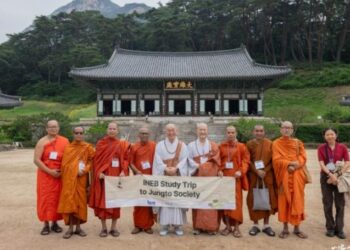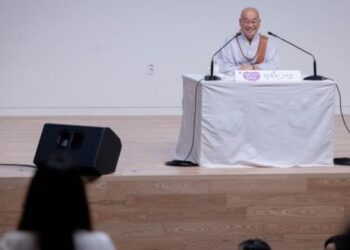Oct 15, 2024 Aegwangwon Autumn Outing, “Pureun Baedal Mal-jip” Book Festival (Ulsan)
Hello. Today is the day for an autumn outing with the residents of Aegwangwon, a residential facility for people with intellectual disabilities.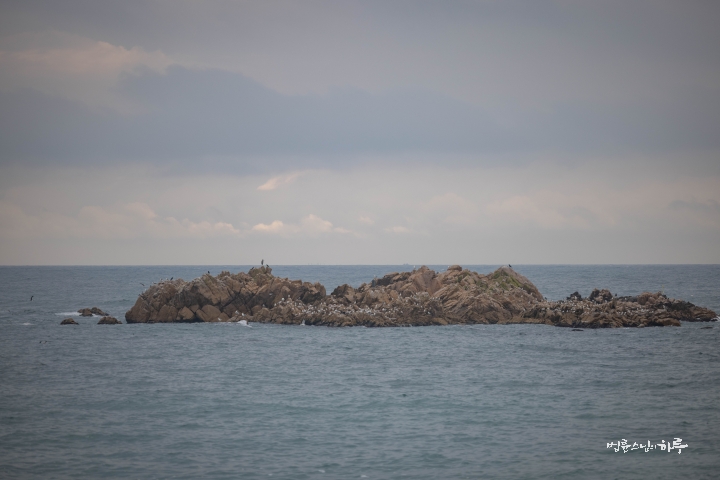
Sunim’s connection with Aegwangwon began 21 years ago. In 2003, when Typhoon Maemi caused severe damage to the southern coast of Korea, Aegwangwon on Geoje Island also suffered significant damage. At that time, JTS helped with the recovery efforts at Aegwangwon. After the restoration was complete, Sunim asked Director Kim Im-soon what else they could do to help. The director replied, “It’s most difficult for people with disabilities to go on outings, so it would be great if you could help with that.” Since then, Jungto Society has been organizing outings with Aegwangwon residents every spring and fall.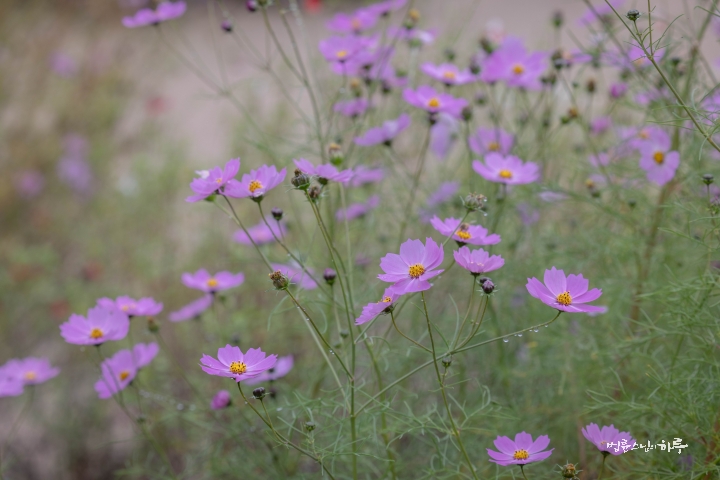
This outing was planned to explore the Gyeongju area. Sunim departed from Dubuk Retreat Center at 9 a.m. and headed to King Munmu’s Underwater Tomb. Upon arriving at the parking lot, about 40 Jungto Society members from the Gyeongnam branch, wearing blue vests, were waiting for the Aegwangwon residents. Sunim greeted the volunteers and waited together for the Aegwangwon residents to arrive.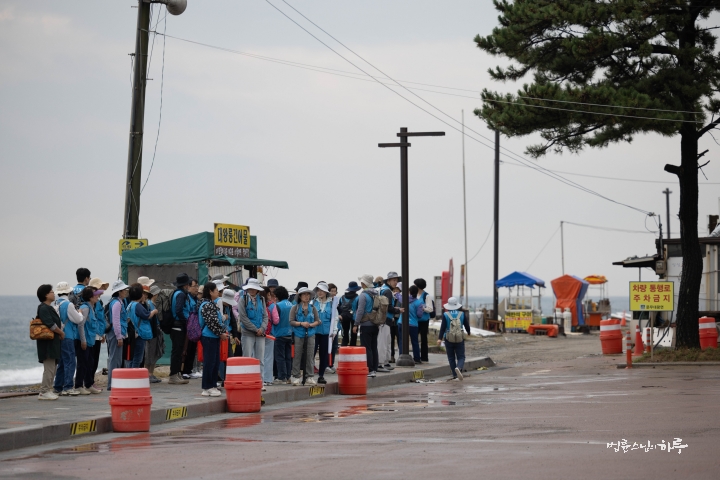
Just after 10 a.m., the bus carrying the Aegwangwon residents arrived. Today, 32 residents with mild disabilities, along with the CEO and 10 staff members, joined the outing.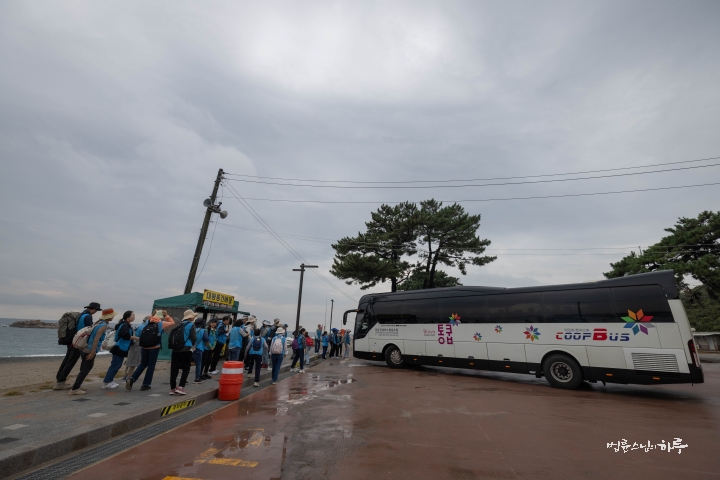
Sunim greeted each person warmly, making eye contact as they exited the bus.
“Nice to see you!”
“Hello, Sunim!”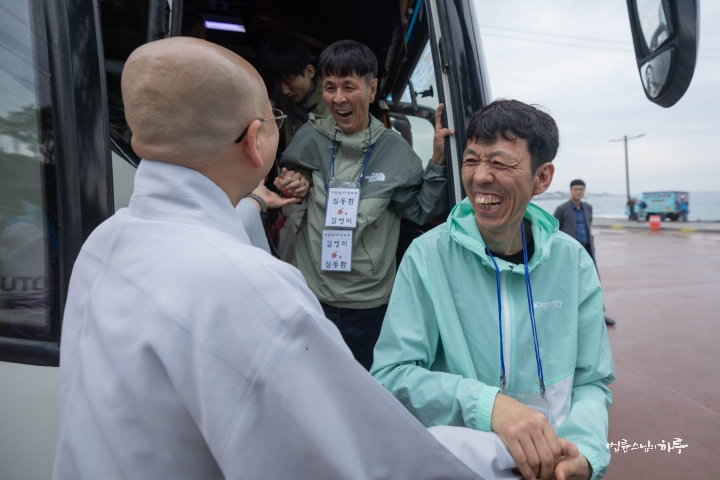
After holding Sunim’s hand while getting off the bus, the Aegwangwon residents then held hands with the volunteers. These were their partners for the day’s outing. Some residents recognized the volunteers’ faces and hugged them tightly.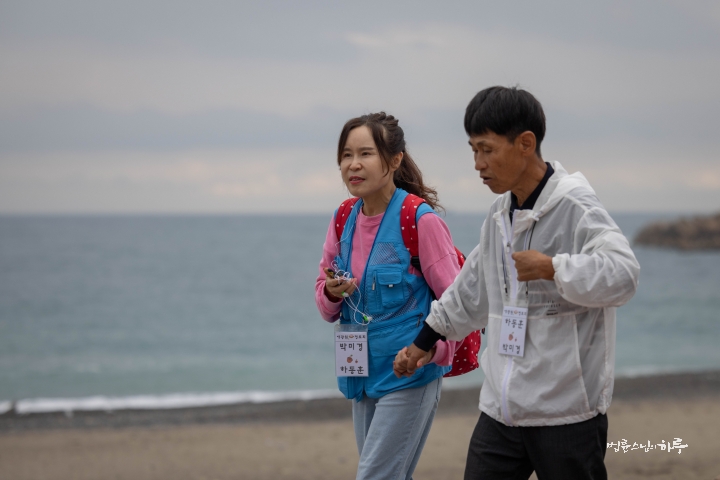
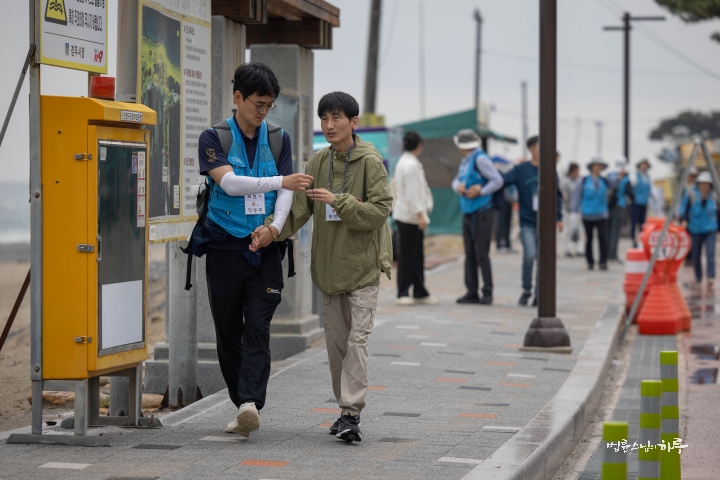
The residents and volunteers, hand in hand, first went to use the restrooms. Sunim waited in front of the information board for King Munmu’s Underwater Tomb until all the Aegwangwon residents had gathered. One person approached Sunim, recognizing him, and greeted him warmly, grasping his hand.
“I, I remember you! What’s your name?”
“It’s Pomnyun.”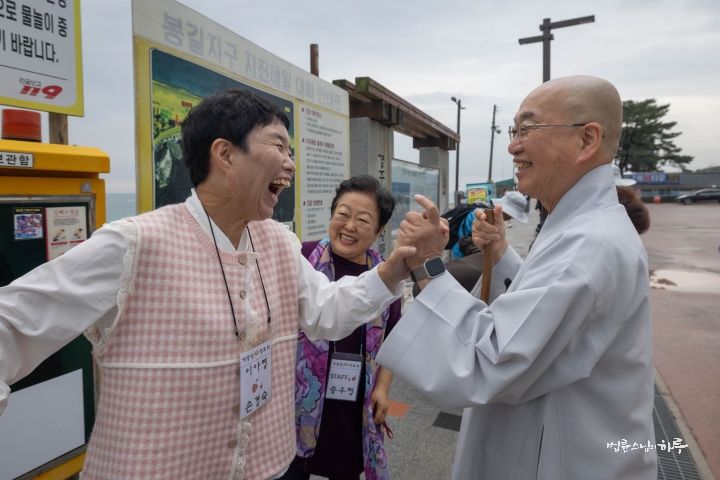
Director Song Woo-jeong, who was listening nearby, said:
“You shouldn’t speak informally.”
Sunim replied with a smile:
“It’s okay.”
His face, with a bright smile, was filled with joy. Soon, when all the residents had gathered, Sunim began to explain.
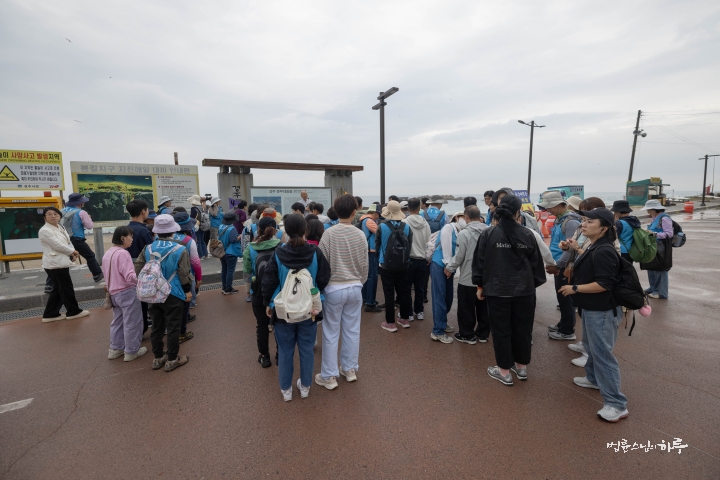
“It’s nice to meet you all. If anyone doesn’t know me, please raise your hand.”
A few people raised their hands high.
“You raised your hands because you know me, right?” (Laughter)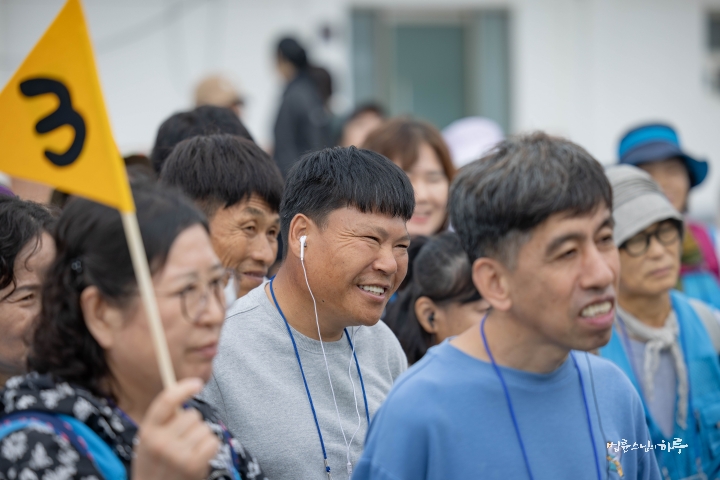
After exchanging warm greetings, Sunim explained about King Munmu’s Underwater Tomb.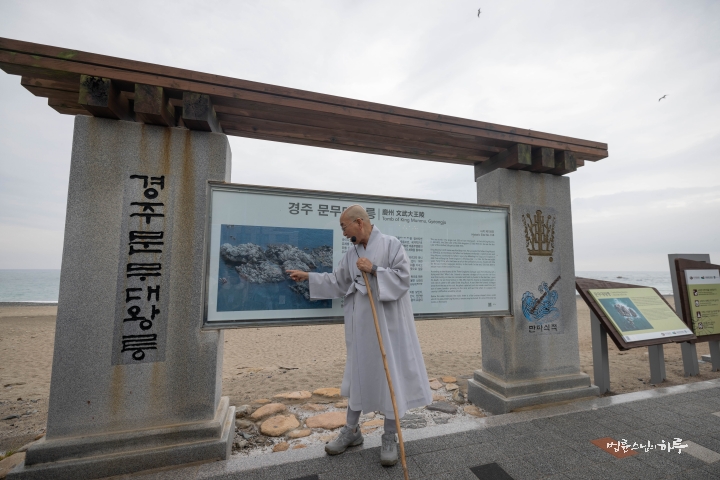
“The place we’ve arrived at today is ‘King Munmu’s Underwater Tomb’ located in Gyeongju city. You know what a ‘king’ is, right? Instead of burying the king’s tomb on land, it was placed in the sea. Do you see that slightly wider rock formation in front? Because King Munmu’s tomb was placed on that rock, we call it ‘Daewangam’ (Great King Rock).”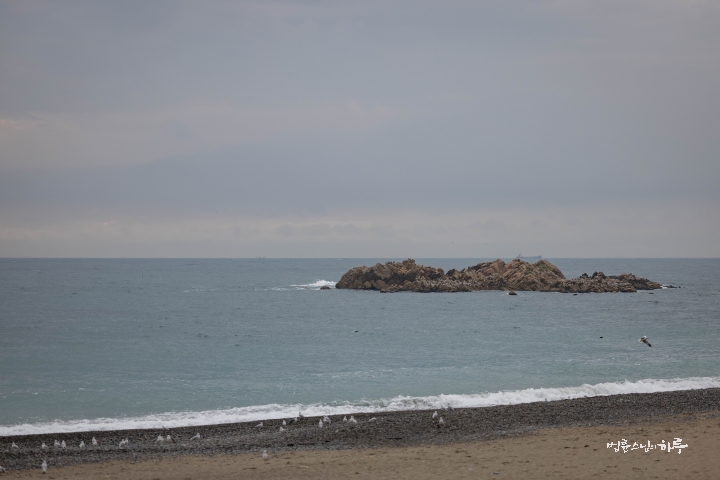
The King Who Left a Will to Build His Tomb on the Sea
The kingdom of Silla lasted for a thousand years, and its 30th ruler, King Munmu, unified the Three Kingdoms. After unifying Goguryeo, Silla, and Baekje, he made a final wish before his death. With Japan being the only remaining potential enemy, he believed that they would inevitably invade across the sea. Therefore, he vowed to become a dragon of the sea to protect against Japanese invasions. Because of this pledge, he left instructions in his will to be cremated and have his ashes buried in the sea after his death. As a result, his tomb was built in the sea. For this reason, his ashes were buried beneath a rock in the East Sea.
Take a look at this photo. When you look down at the rock from above, you can see that the center is naturally split in the shape of a cross. It’s divided from top to bottom and from left to right, with the center as the focal point. One side is completely split, while the other is not entirely separated. It didn’t quite form a perfect cross. So, with each wave, water flows in and out of the grooves. You can see a flat stone in the middle of the cross shape. This is a small rock. The urn containing the ashes was placed underneath this rock and weighed down with it.
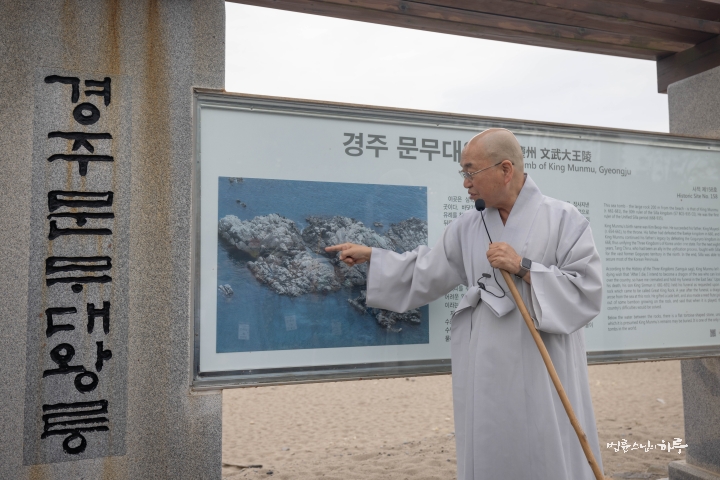
The grooves in this rock were not naturally formed. Upon closer inspection, there are traces of artificial carving. This rock was discovered by archaeologists, confirming a legend as historical fact. Because it contains the remains of a king, it is called ‘King Munmu’s Tomb’.
“Today, our goal is to enjoy the beach while looking at King Munmu’s Tomb. Let’s go to the beach, fly kites, and have a good time.”
The residents listened to the explanation with bright eyes, nodding their heads.
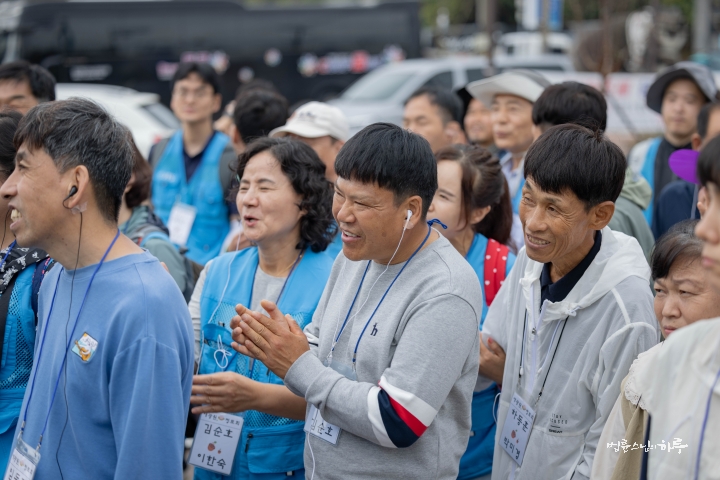
Next, Ms. Song Woo-jeong the director of Aegwangwon, gave a greeting.
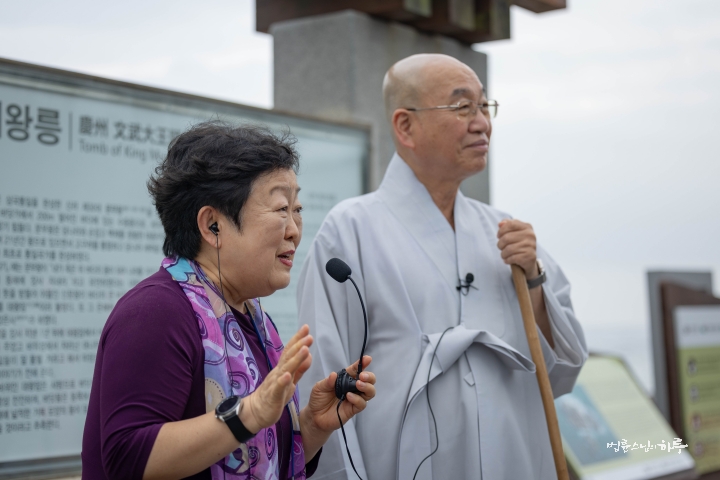
“Jungto Society members and Venerable Pomnyun Sunim, it’s nice to see you. The weather seems a bit chilly today. Strangely, whenever Aegwangwon goes on an outing, the weather always clears up. Today, the rain has stopped, allowing us to have a nice outing. Everyone has taken time out of their busy schedules to be here. I hope you all have an enjoyable and meaningful time. Sunim, thank you for taking time out of your busy schedule to explain things in detail to our friends and for always making time for us.”
As the weather was mentioned, Sunim smiled and said:
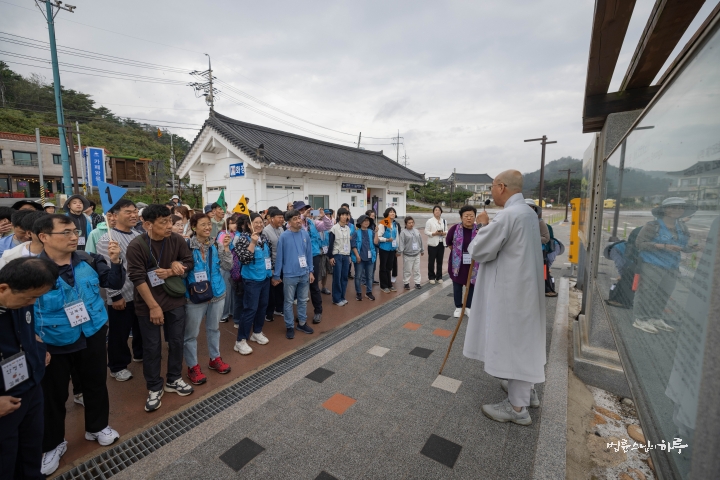
“This weather, with the sun briefly hidden, is actually nice. When the sun is out, your face and head can feel hot. For someone like me without hair, the sun feels even hotter. So, I often prefer weather like this. In the afternoon, the sun will come out from behind the clouds, and the weather will become bright. Then, let’s take a walk along the beach.”
The volunteers walked hand in hand with the residents along the beach.
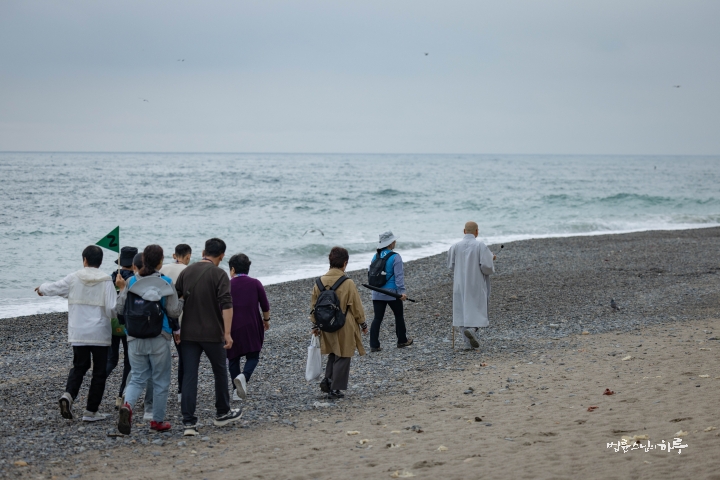
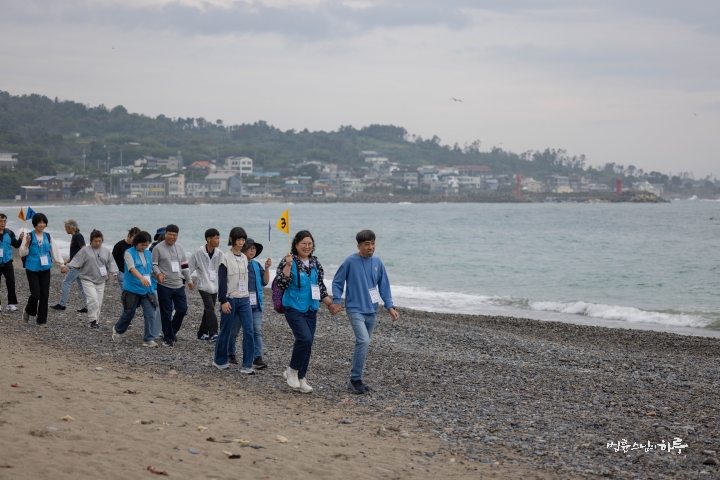
As the sound of crashing waves echoed in their ears and the cool breeze brushed their faces, the residents’ expressions became more relaxed. They savored the freedom in the sea and wind.
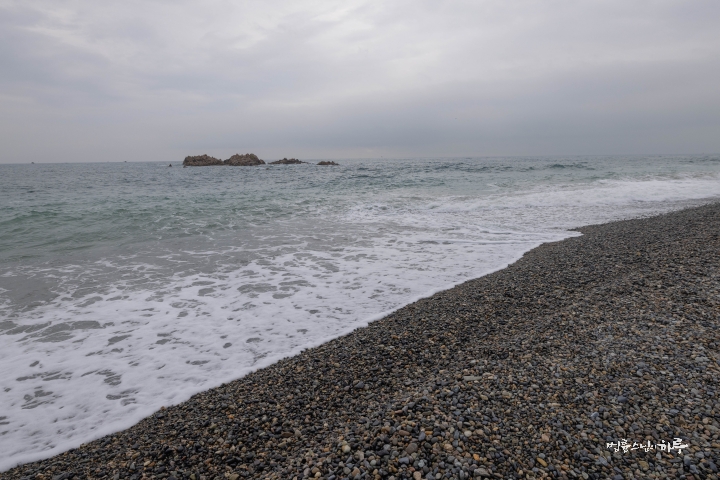
One resident put his arm around Sunim’s shoulder. This person always seems the happiest to see Sunim, as if meeting a friend.
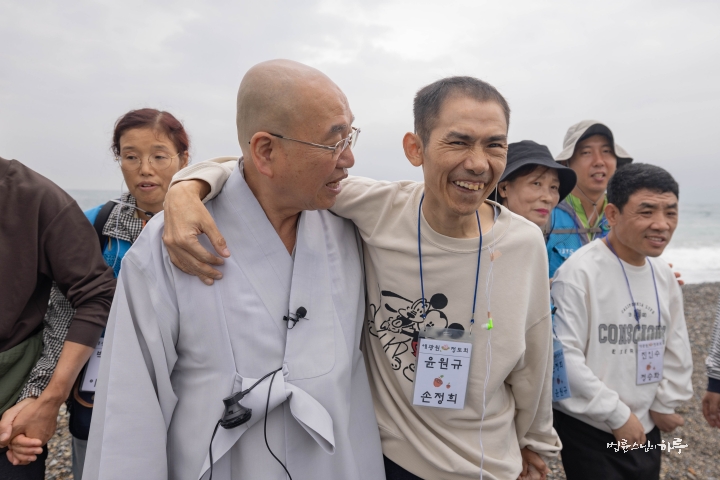
With Daewangam in the background, everyone took a group photo together. They also took individual group photos.
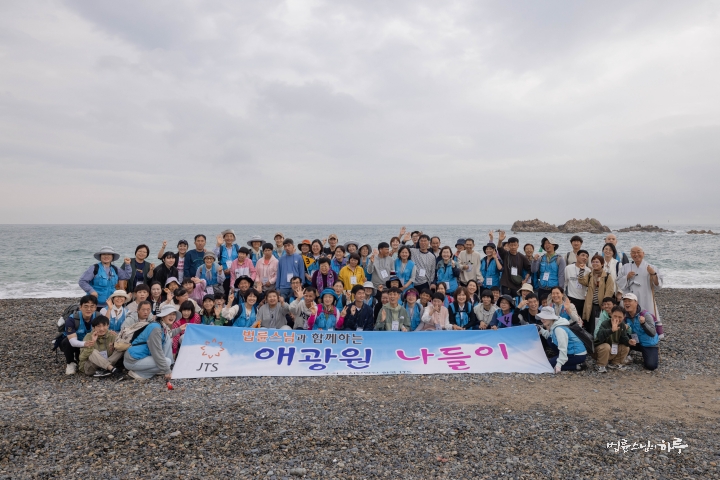
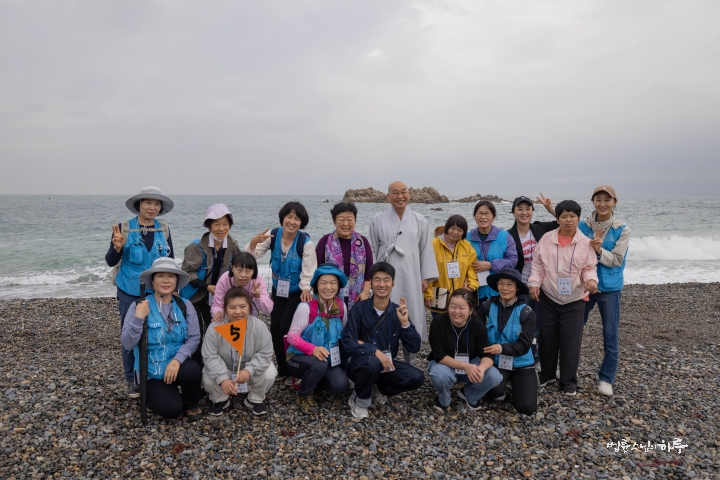
Today, taking advantage of the sea breeze, the residents tried kite flying, an activity they rarely get to do. Sunim helped launch the kites from behind as the residents held the strings and ran. No kite went up on the first try. Even when the kites didn’t take off, the residents’ faces were full of smiles as they ran with the kite strings.

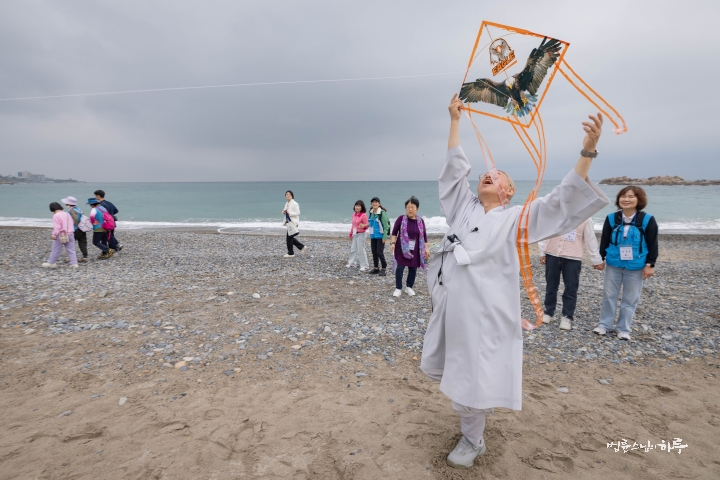
After several attempts, the kites finally caught the wind and soared into the sky.
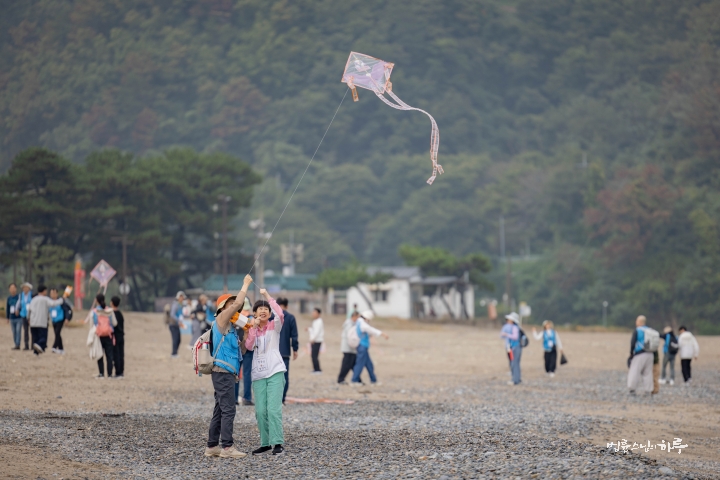
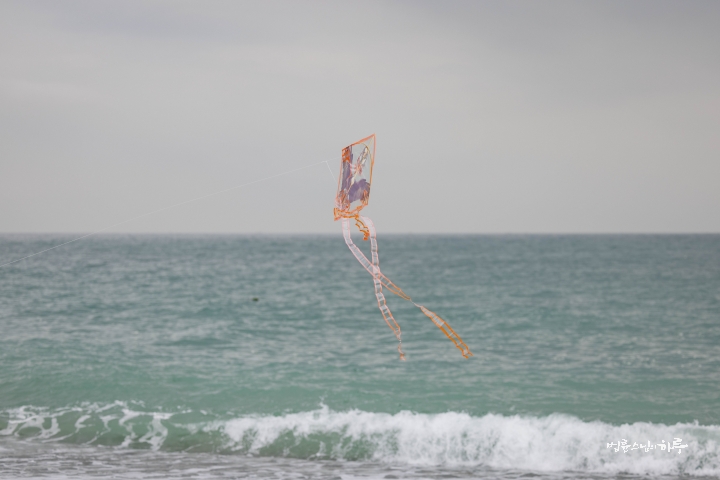
After enjoying this fun time, they boarded the bus again and headed to Gameunsa Temple Site. There was concern about the stairs at Gameunsa, but the residents who came on this outing all had mild conditions, so it seemed quite possible for them to climb.
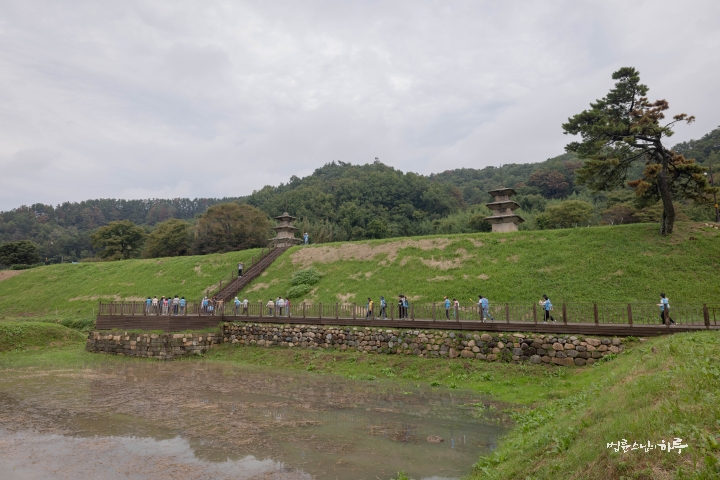
Before climbing up to the three-story stone pagoda, Sunim explained about Gameunsa.
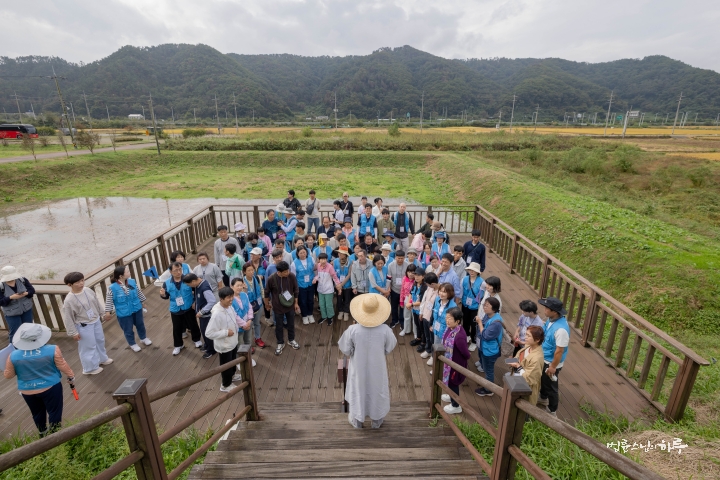
“We have now arrived at Gameunsa. Let’s say it together. Gameunsa.”
“Gameunsa.”
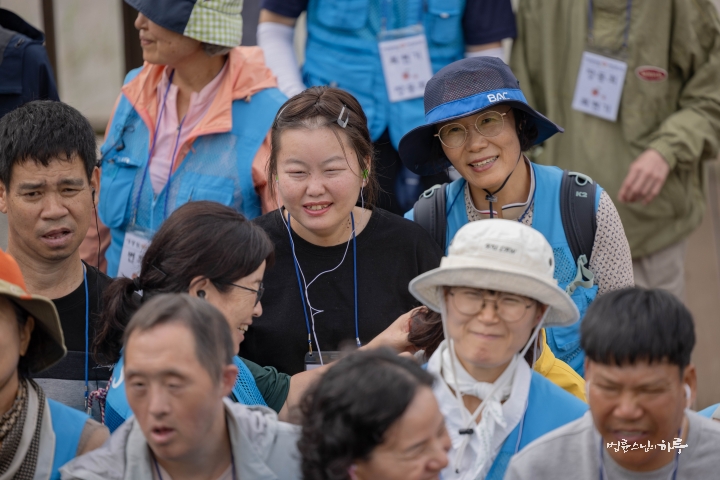
“It’s called Gameunsa because it expresses gratitude for grace. It was built to show gratitude for King Munmu’s grace in unifying the Three Kingdoms and making Silla the center. Remember I mentioned earlier that King Munmu made his tomb in the sea? King Munmu vowed to become a dragon after death to protect against Japanese invaders. So, the Silla people believed that King Munmu had become a dragon. They built this temple so that the king-turned-dragon could come from the rock we saw earlier, follow the water path, and listen to the dharma teachings under this hall. It doesn’t seem very believable, does it?” (laughs)
The residents seemed unsure even after listening to Sunim’s explanation.
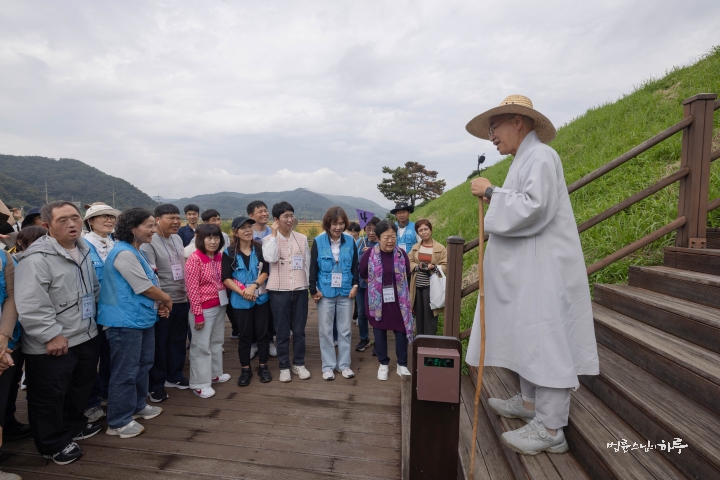
“If you look at the bottom of that embankment, you can see a place where boats could dock and tie their ropes. It’s a kind of pier. We’ll go up these stairs to the temple. Shall we go up?”
“Yes!”
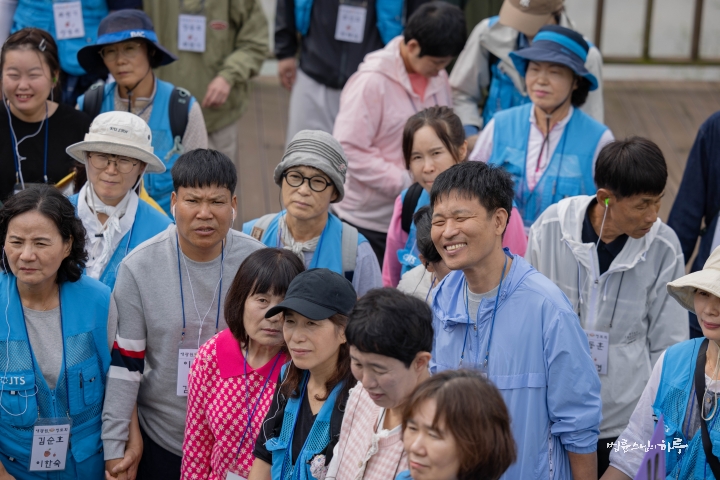
Everyone carefully began to climb the stairs. While on the stairs, they took a commemorative photo.
“Okay, turn around! We’re going to take a picture.”
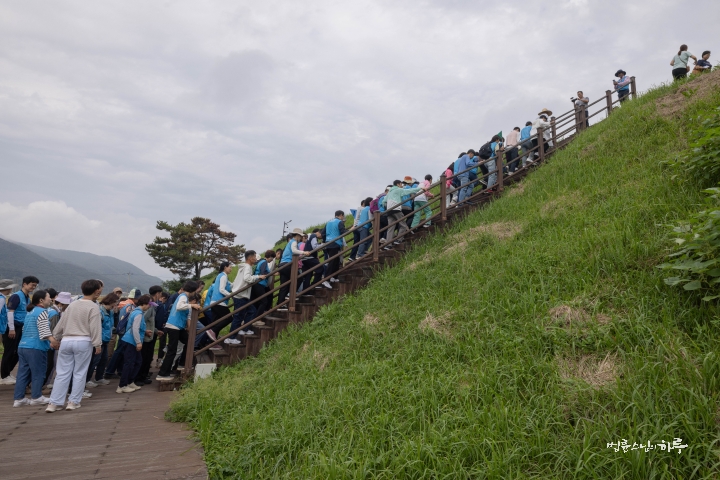
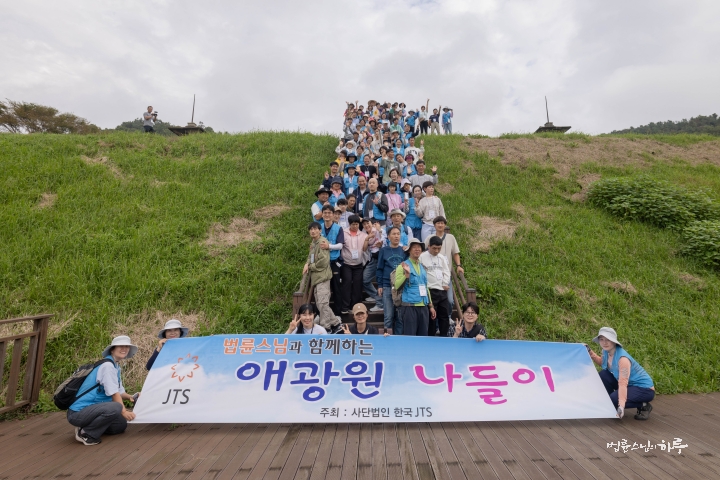
They turned back and continued climbing the stairs. The towering east and west pagodas came into view. Past the pagodas, they could see the floor of the hall where, as Sunim had explained, the king-turned-dragon was said to have arrived following the water path.
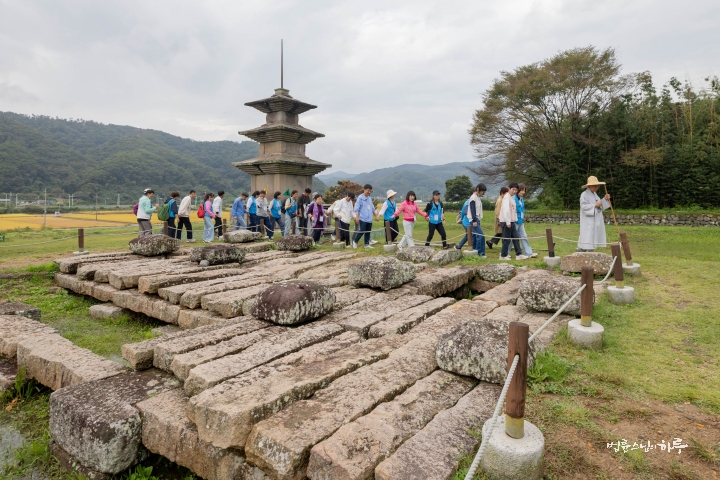
“Come up slowly. Usually, temple floors are covered with wood, aren’t they? But here, they filled the temple floor with water. Why do you think they did that? It was to allow the dragon to come up. They made stepping stones over the water and then built a stone floor on top, thinking that the dragon could listen to the dharma teachings from below. This is the only temple built this way in Gameunsa. They made it so water could flow in and out. Then, they placed foundation stones on top of the rocks and built the hall.
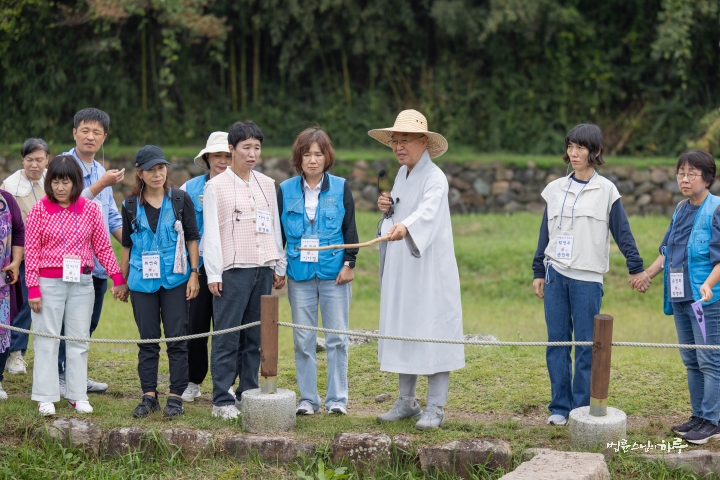
“Behind that is the lecture hall. The typical structure of a temple is always the pagoda first, then the main hall, and then the lecture hall. Now, let’s turn around and head out.”
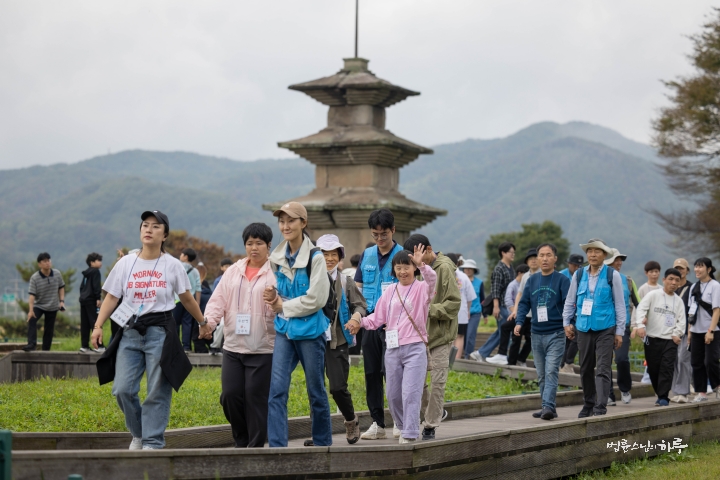
From a position where both the east and west pagodas were visible, the group once again unfurled the banner and took a commemorative photo.

The next destination was Girimsa Temple, located at the foot of Hamwolsan Mountain in Gyeongju. It was only a 20-minute drive away. After parking, the group passed through the One Pillar Gate and encountered a gently sloping path. One of the residents approached and firmly grasped Sunim’s hand.
“Oh my, you walk better than I do. I feel like I’m being pulled along,” Sunim said with a laugh.
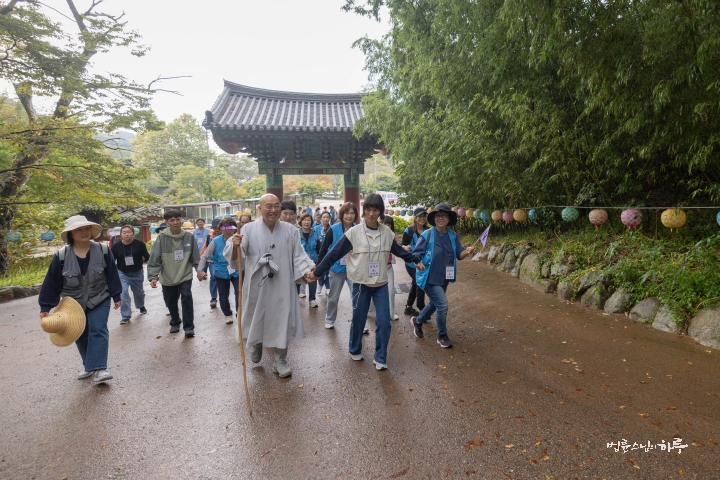
Walking slowly, step by step with his companion, they soon reached the Four Heavenly Kings Gate. Sunim provided an explanation about Girimsa Temple in front of this gate.
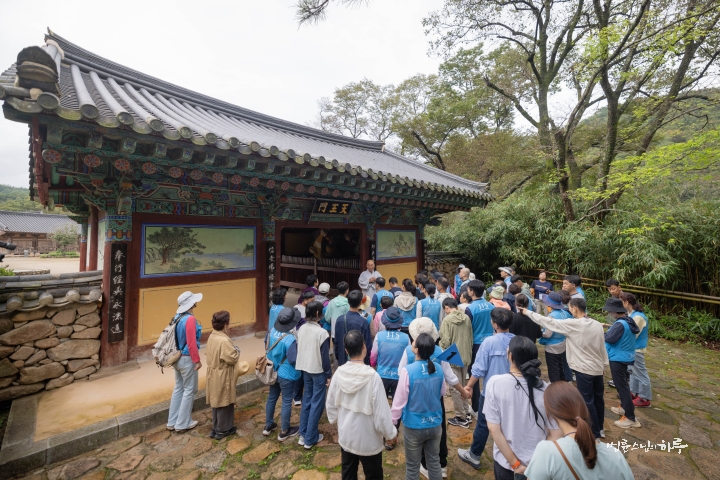
“The name of the temple we’ve arrived at is Girimsa. What’s it called?”
“Girimsa.”
“The Chinese characters for Girimsa use the ‘Gi’ (祇) from Jetavana Monastery in India and the ‘Rim’ (林) meaning forest. This temple was built during the reign of Queen Seondeok in the Silla period. During the Japanese colonial era, this temple was the main temple, but now Bulguksa has become the main temple, and Girimsa has become a branch temple. Originally, Girimsa was an extremely large temple, and during the Japanese invasion of Korea in 1592, monk soldiers were stationed here. The Jinnamru Pavilion at Girimsa was the headquarters building for the monk soldiers in this region. During the Japanese invasion, when the government forces were overwhelmed by the Japanese army’s momentum, volunteer armies rose up all over the country, and even monks stepped up to fight. Originally, monks shouldn’t fight, but because the country was in danger, they organized monk armies to protect the nation. This temple has many treasures. There are five national treasures here. They say they’ve also arranged a nice display of chrysanthemums for autumn. We’ll take photos in front of the chrysanthemums and spend about an hour looking around Girimsa. Let’s take our time and enjoy the sights without rushing.”
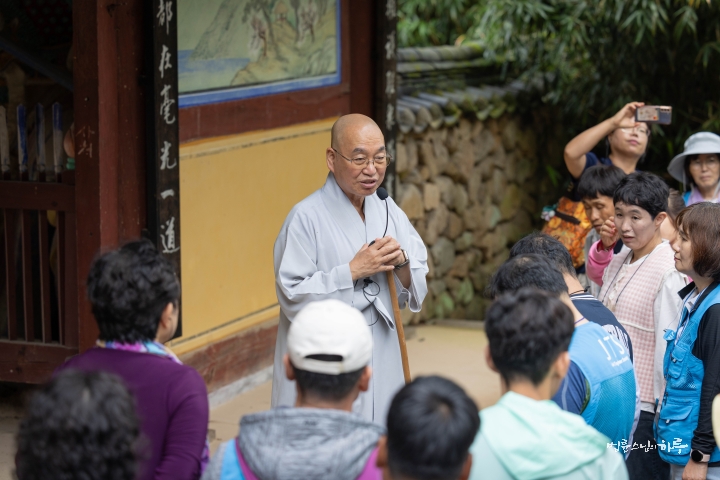
The first gate you always enter when going into a temple is called Ilju-mun (One Pillar Gate). It’s the first gate we passed through after getting out of the parking lot. The Ilju-mun serves as a dividing line – on this side is the Buddha’s realm, and on that side is the realm of sentient beings. However, in reality, this side and that side are not two separate things, but one. To signify that they are not separate, it is sometimes called Buri-mun (Gate of Non-duality).
After passing through the Ilju-mun and walking for a while, you come to the Sacheonwang-mun (Four Heavenly Kings Gate), which leads into the temple grounds proper. We are now in front of the Sacheonwang-mun. In Indian mythology, when you ascend from the human world to heaven, you first encounter a realm with heavenly deities. The Four Heavenly Kings are celestial beings who preside over the four cardinal directions. That’s why there are sculptures of the Four Heavenly Kings here. Looking at the Four Heavenly Kings, do they seem scary or not scary to you?
“They look scary.”
“There’s no need to be afraid. The Four Heavenly Kings capture bad people but protect good people. Now that we’ve passed through the Sacheonwang-mun, we’re entering the temple grounds. Let’s go in.”
After finishing his explanation, Sunim passed through the Sacheonwang-mun and entered the temple grounds. He walked slowly, keeping pace with the residents.
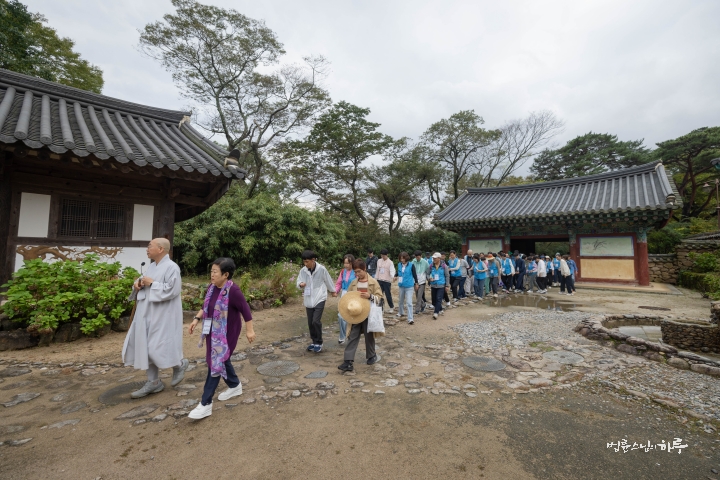
“Take your time coming in.”
After passing the Jinnamnu Pavilion, which was built to defend against foreign invaders, the Daejeokgwangjeon Hall, Yaksa Hall, and Eungjinjeon Hall were clustered together. The tranquil ancient temple was adorned with colorful chrysanthemums in full bloom. Exclamations of joy burst forth from among the residents.
“Wow!”
“It’s beautiful!”
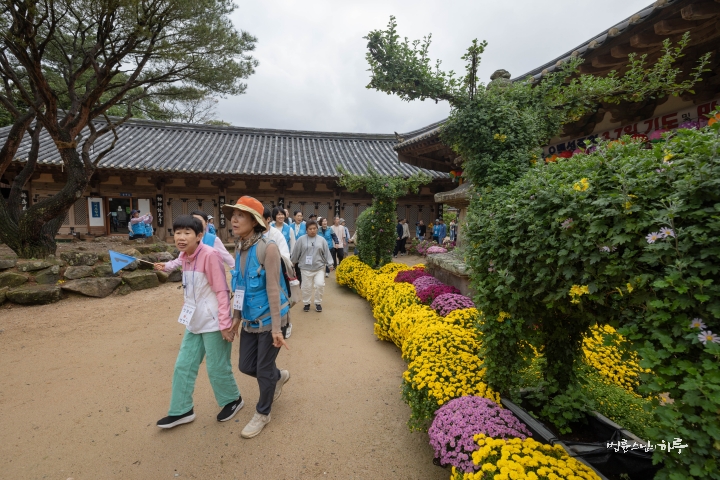
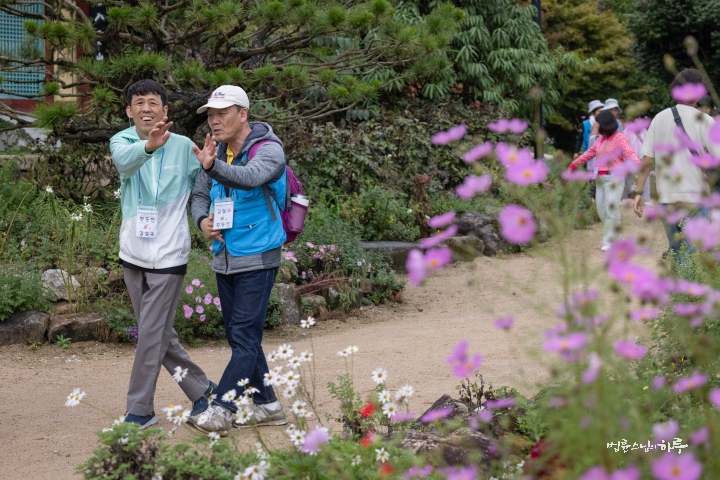
In front of the Daejeokgwangjeon Hall, Sunim explained the hand gesture of Vairocana Buddha.
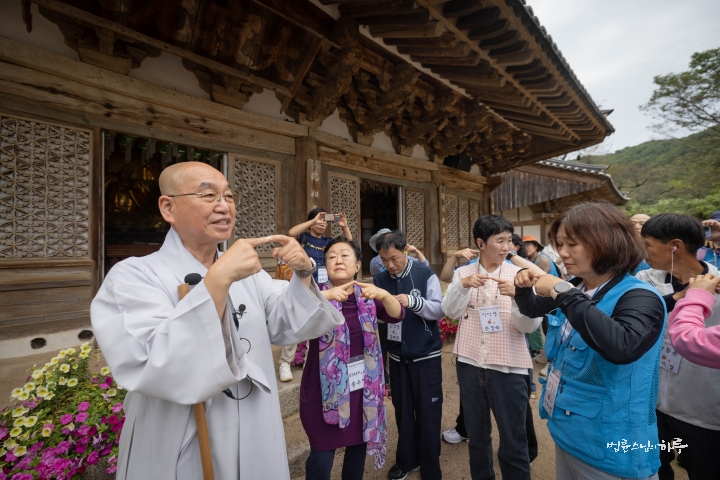
“If you look at the hand gesture, the tip of the left index finger and the tip of the right thumb are touching, and then the right hand is wrapping around the left index finger. This is called the ‘wisdom fist mudra’. When you see this hand gesture, it represents Vairocana Buddha.”
The residents followed Sunim’s lead and imitated the hand gesture of Vairocana Buddha.
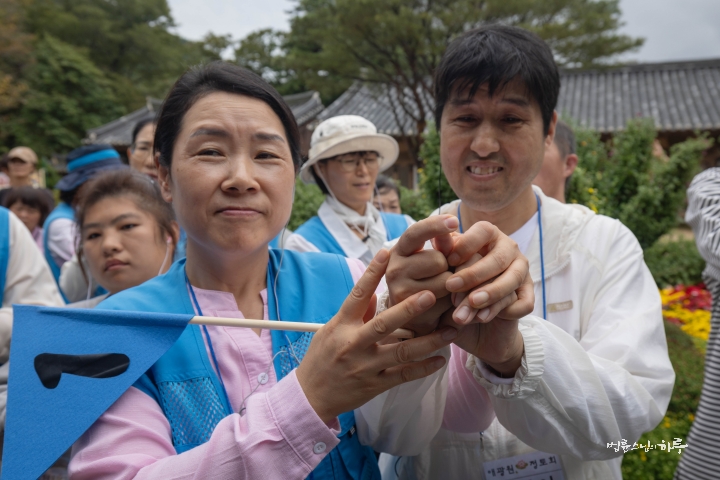
Chrysanthemums of various colors – yellow, red, pink – were in full bloom everywhere. The residents took photos with their partners in front of the chrysanthemums. Sunim personally took photos for some of them.
“Now, look over here.”
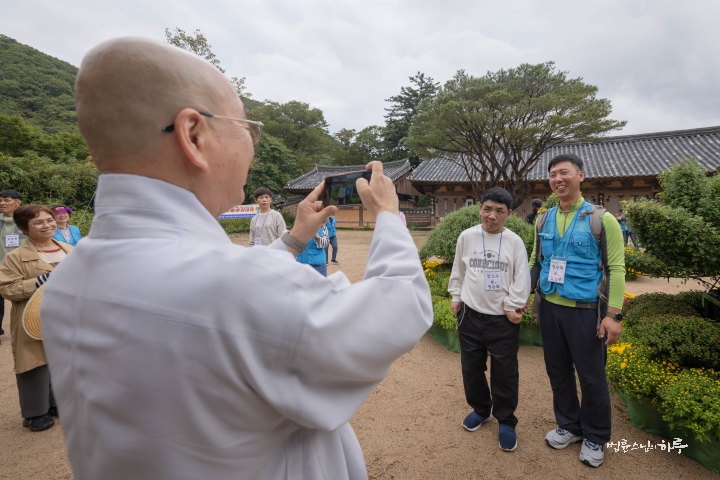
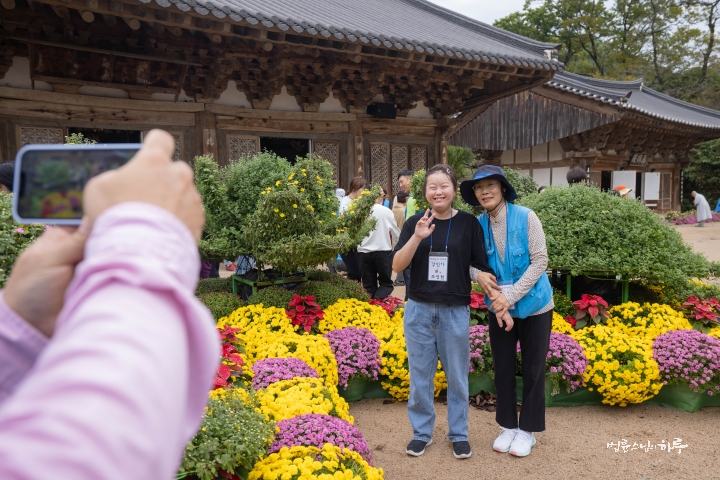
They climbed the stone steps to the Samcheonbuljeon Hall, which houses three thousand Buddha statues. In front of the Samcheonbuljeon, Sunim took group photos again and also took photos with the Aegwangwon staff.
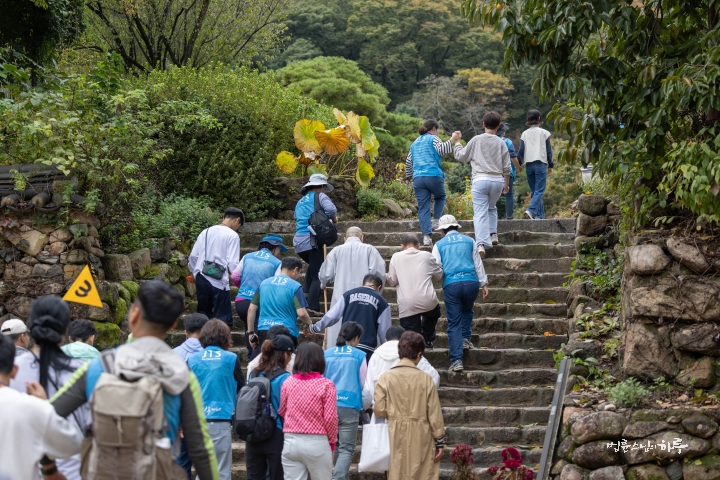
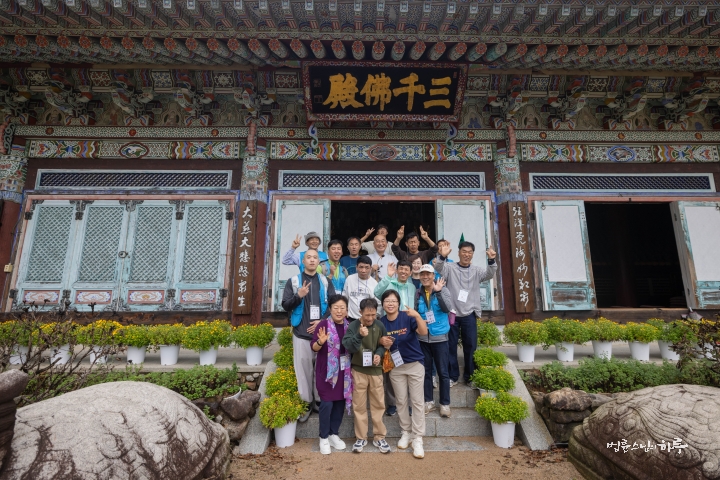
Girimsa Temple is famous for its good-tasting water. Everyone took a sip of water from the well before getting back on the bus.
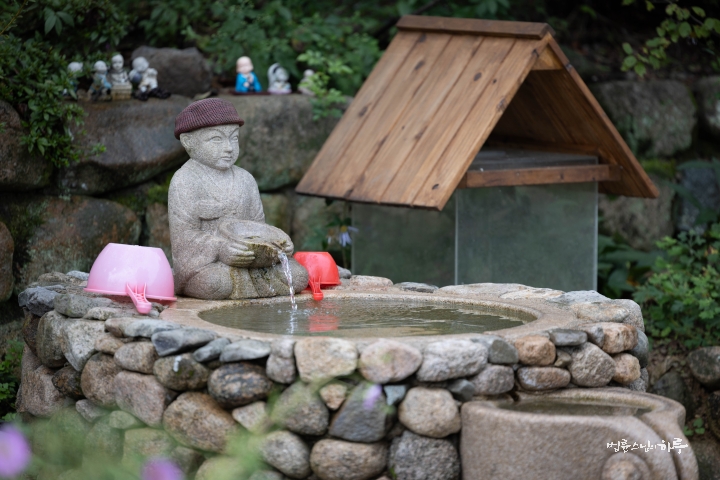
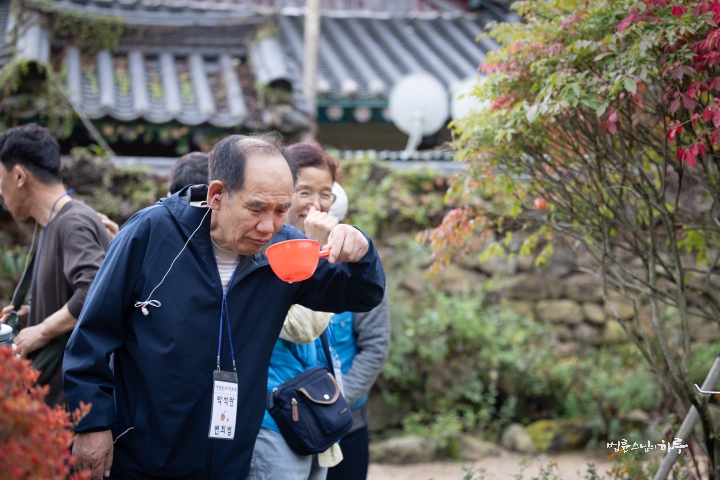
Everyone headed to the dining hall. The volunteers sat across from the residents one-on-one at the tables, helping to feed them a meal.
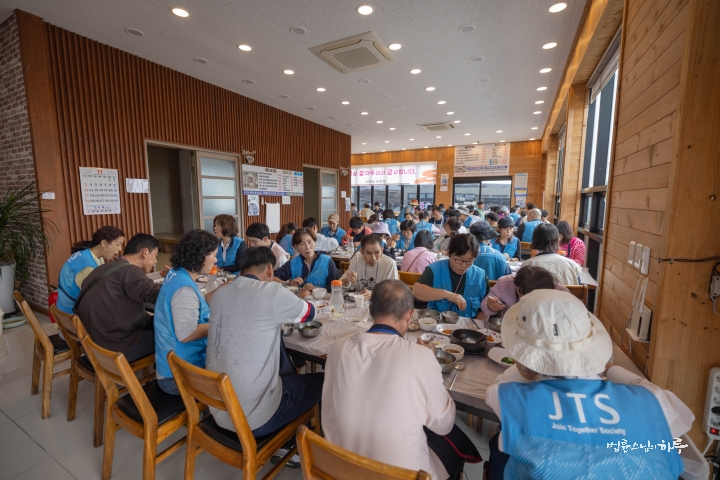
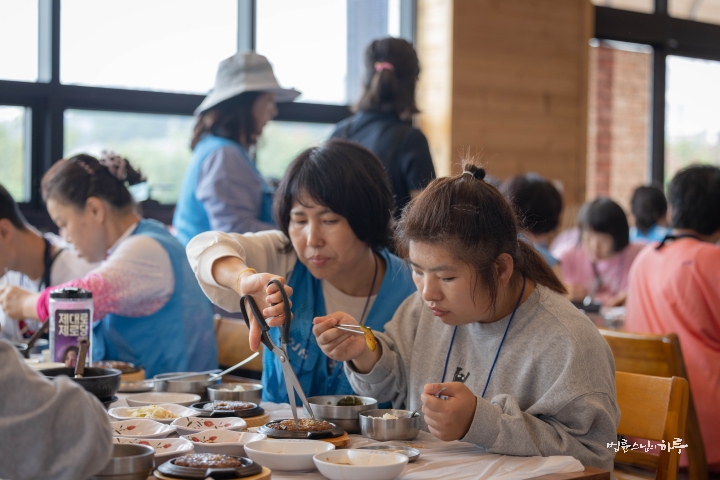
The residents seemed to be in a good mood on this rare outing, blowing hearts to the volunteers and putting their arms around each other’s shoulders as they enjoyed their meal.
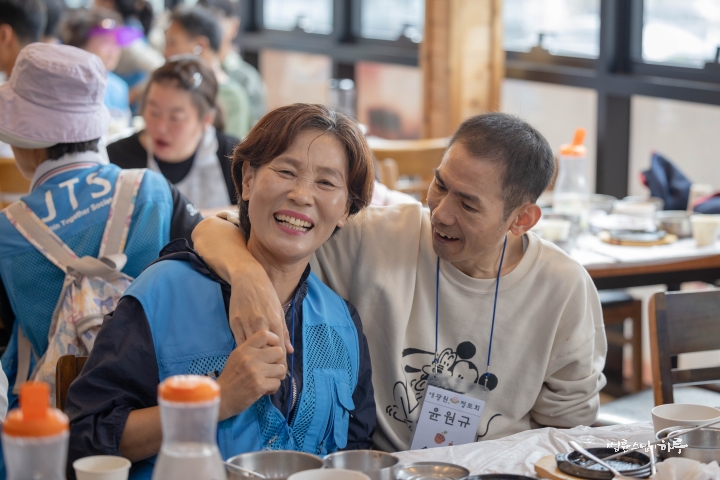
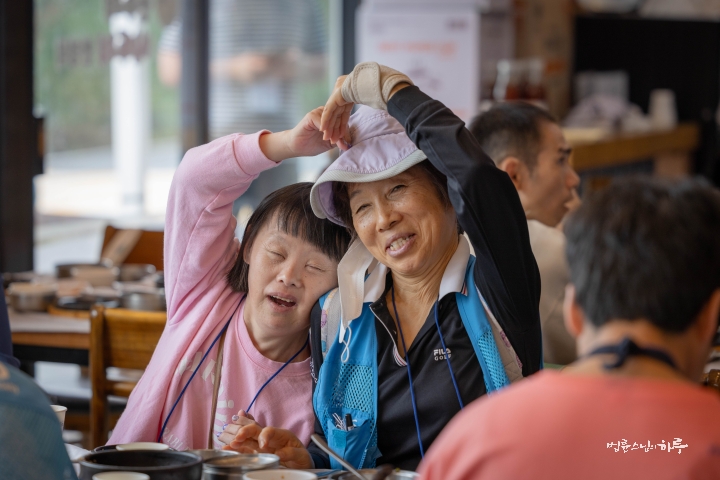
After finishing the meal, they headed to the Gyeongju Millennium Forest Garden in the afternoon. As they entered the forest, lush greenery spread out from the entrance. The clear, refreshing air invigorated their minds.
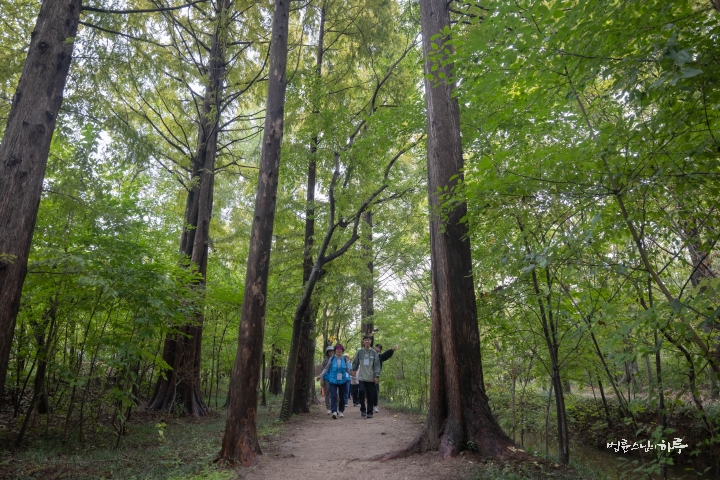
Sunim walked slowly along the forest path with the residents. Fringe trees and elm trees were growing very densely.
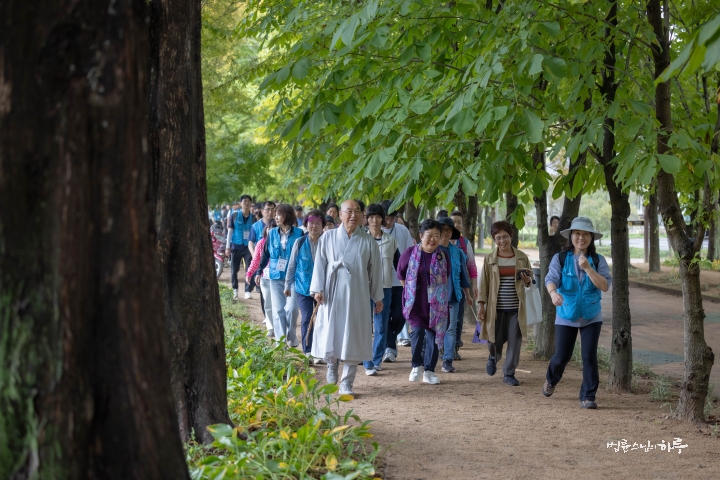
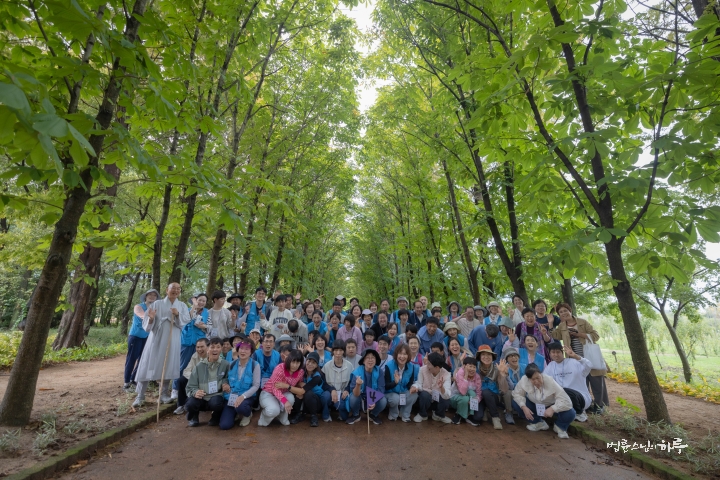
A single log bridge crossed over a small stream lined with dense metasequoia trees. The reflection of people crossing the log bridge mirrored in the stream like a mirror.
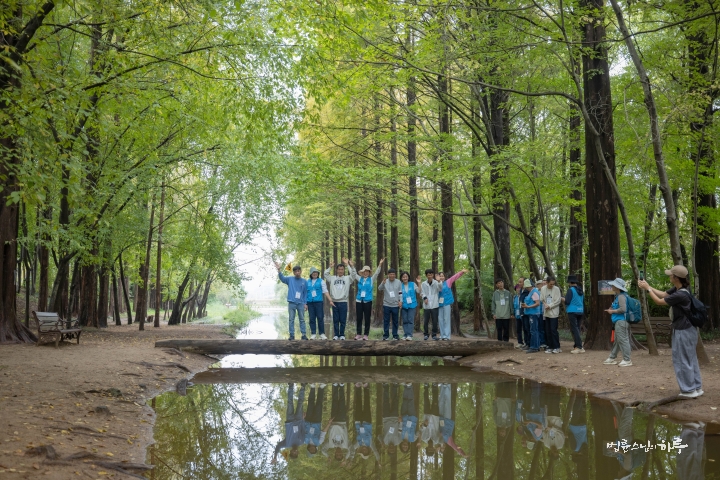
Despite being located in the middle of Gyeongju city, the forest was quite large and spacious. The groups freely strolled along the walking paths, capturing beautiful moments in photos.
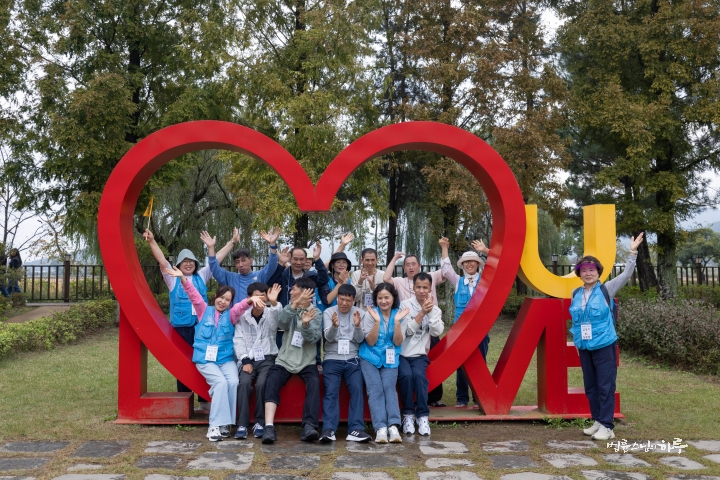
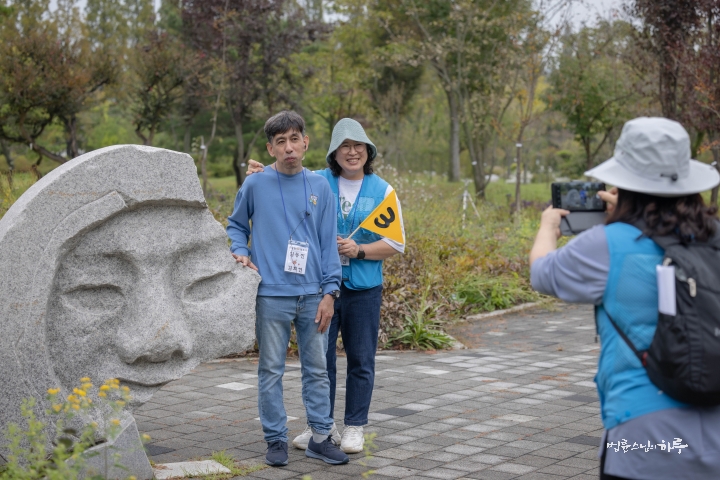
After leaving the garden, they got back on the bus and headed to Woljeong Bridge. Upon arriving at Woljeong Bridge, Sunim continued his explanation.
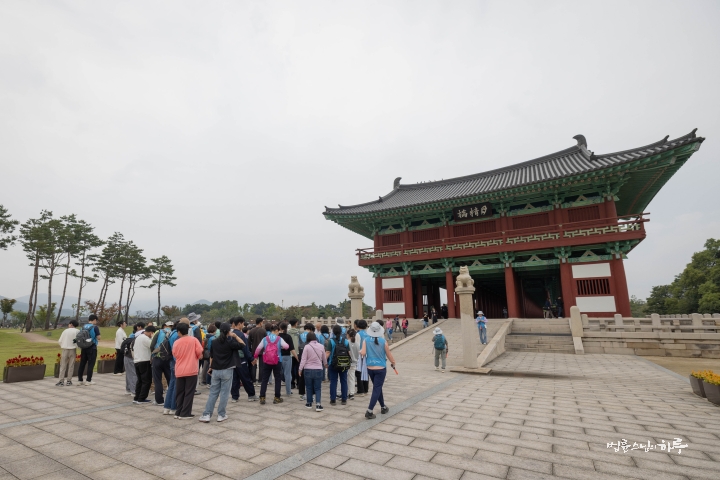
“Did you enjoy your lunch?”
“Yes.”
“Did you enjoy walking in the forest?”
“Yes.”
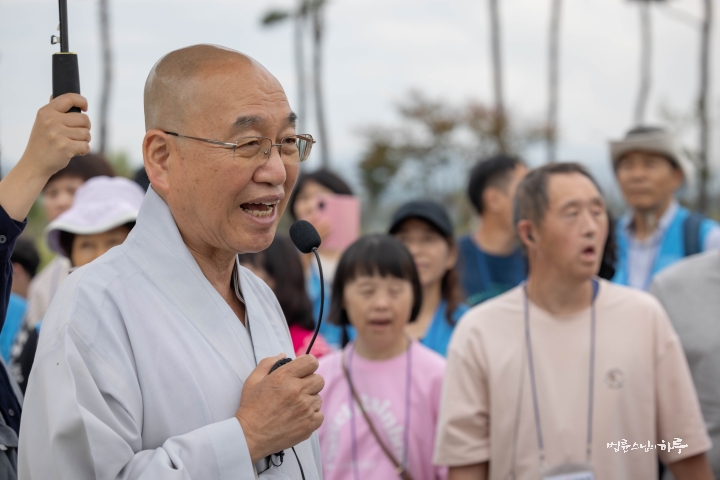
“There’s a beautiful structure in front of us, right? This is a bridge. They built this bridge so beautifully. During the Silla Dynasty, there were several bridges like this, but this one is the most famous. The name of this bridge is Woljeonggyo. There’s a legend associated with this bridge. It’s a story about Master Wonhyo, the most famous monk of the Silla period. Master Wonhyo was coming from Namsan Mountain in Gyeongju and had to cross this bridge. He was so captivated by the moonlight that he stopped to gaze at the moon, but he accidentally fell off the bridge and into the water.”
“Oh no, what happened?”
When one of the residents responded, completely absorbed in Sunim’s story, everyone laughed. Sunim smiled and continued the story.
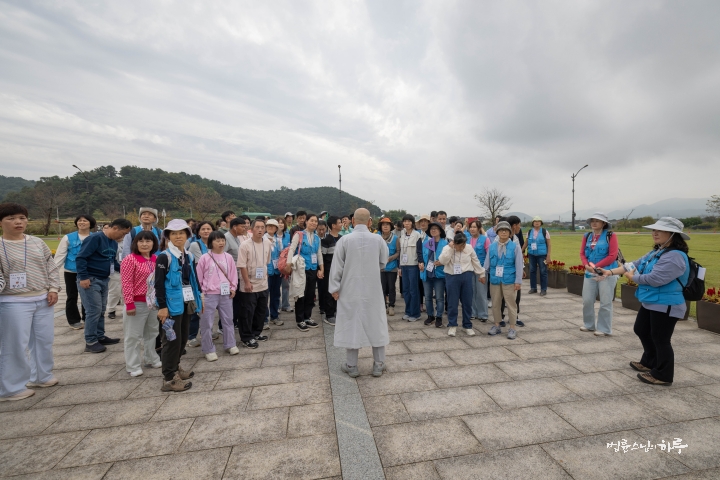
“When Master Wonhyo fell into the water and got all wet, Princess Yoseok, who lived alone next to Woljeong Bridge, said, ‘Monk, your clothes are all wet. Please come to my house and change your clothes.’ Master Wonhyo followed Princess Yoseok to change his clothes, but ended up falling in love with her. They had a son, who became Seol Chong, the most brilliant scholar of the Silla period. After that, Master Wonhyo quit being a monk and went around calling himself ‘Layman Soseong’.
When you cross this bridge, you’ll see the Choi Rich Family House ahead. The Choi family maintained their wealth for 12 generations, which is why it’s called the Choi Rich Family House. There were principles that the Choi Rich family followed for generations that allowed them to maintain their family wealth for such a long time. They never let their family assets exceed 10,000 seok(about 144kg) of rice. They didn’t buy land during years of poor harvest. Why? Because land prices would drop too low during those times, and it would be unfair to those who had to sell their land. So they didn’t buy land during poor harvest years. They also opened their family granaries to help people within a hundred li (about 40 km) so that no one would starve to death. They always treated guests generously, and when a daughter-in-law entered the family, she was required to wear plain hemp clothes for three years. This rule was set to ensure that the future mistress of the house would live frugally. Next, even if family members passed the civil service examination, they never took official positions. They only accepted honorary positions up to the level of jinsa. The reason for this was that holding both power and money together would inevitably lead to problems later. In modern terms, it means they only engaged in economic activities and stayed out of politics. They maintained their family wealth this way for about 400 years, and then used much of it to support the independence movement. The remaining assets were used to establish what is now Yeungnam University. Currently, an academy has been established at the Choi Rich Family House in Gyodong to pass on the family’s philosophy. We’re going there now.”
After finishing his explanation, they crossed Woljeong Bridge together.
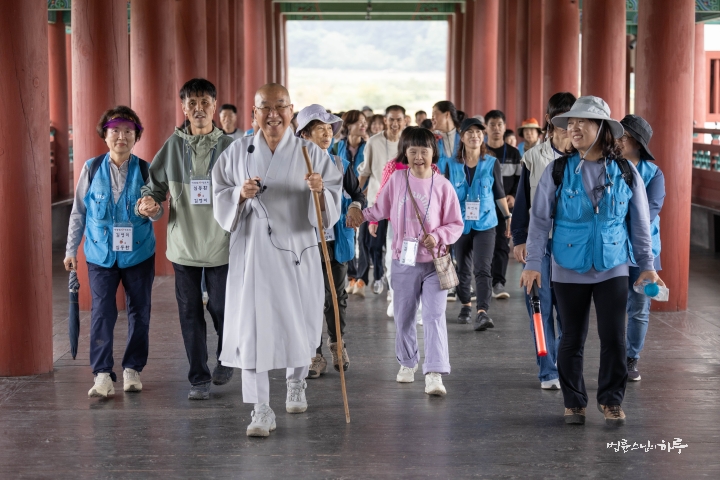
They arrived at the Gyeongju Choi Family Academy after passing through an alley full of traditional houses.
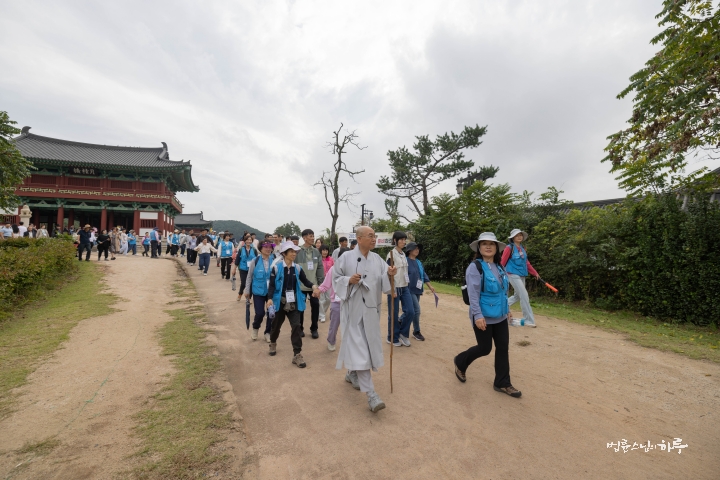
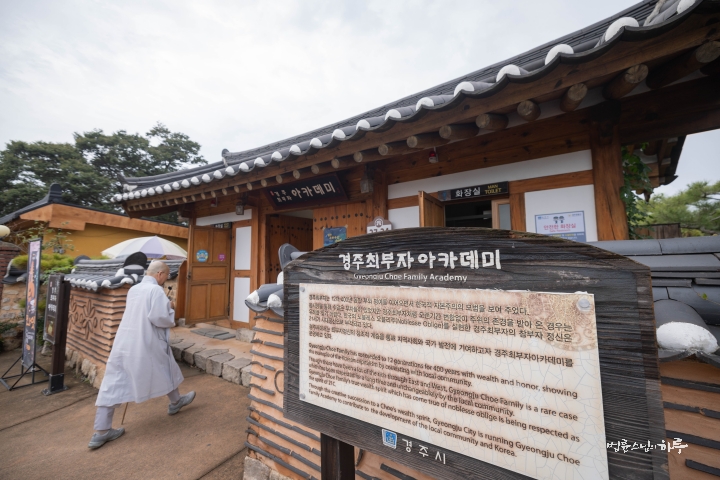
Upon arriving at the Gyeongju Choi Rich Family Academy, they sat on the wooden porch and spent time playing together. Sunim announced the start of a singing contest.
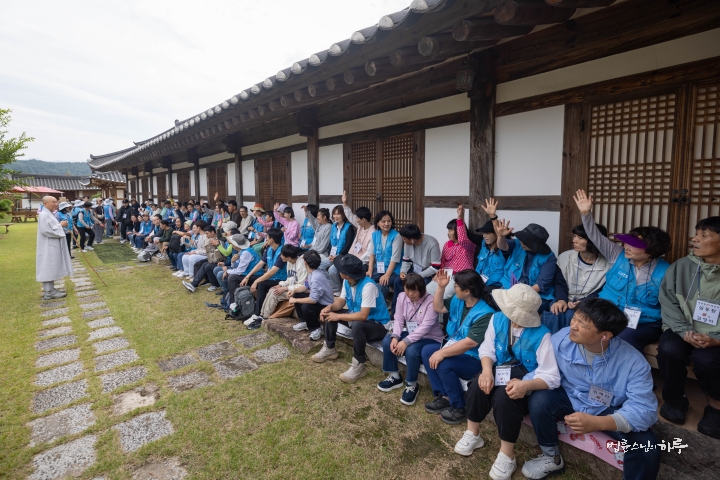
“Do you like it here?”
“Yes!”
“I came here a few years ago. Does anyone remember?”
“I do!”
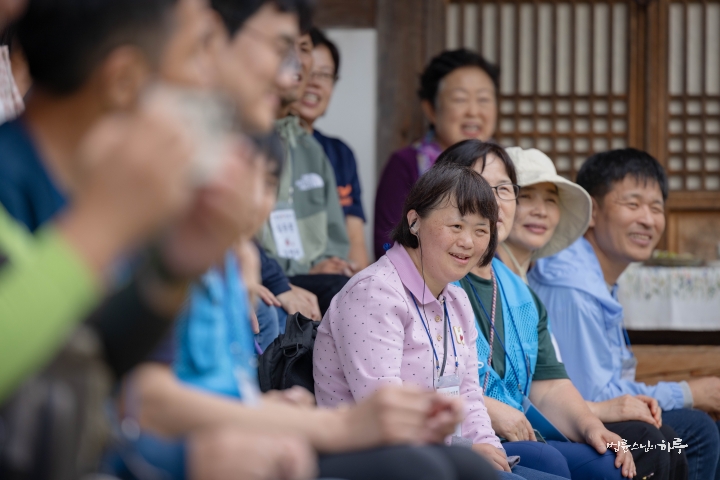
“Do you really remember coming here?”
“Yes. We came last year.”
“You came last year?”
“Yes, we came last year!”
“I see. Today, we’re going to sing songs and have fun here to our heart’s content.”
“Yes.”
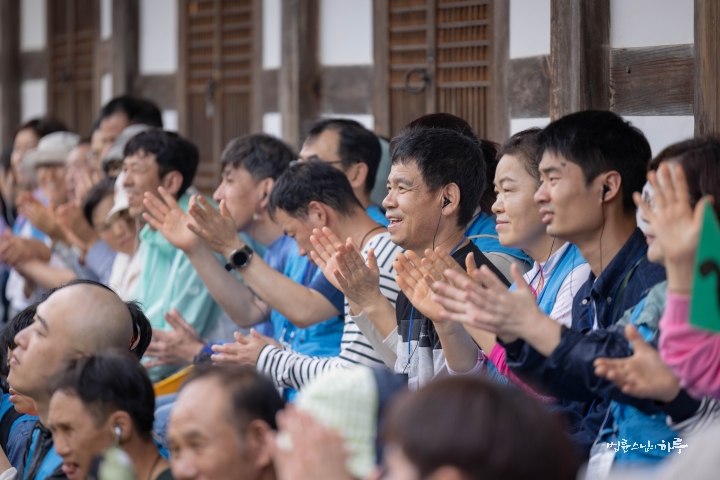
Lee Soo-jin, a Jungto Society member and Gyeongju cultural heritage guide, specially took on the role of MC. As the singing contest officially began, residents who wanted to sing lined up. The competition was fierce.
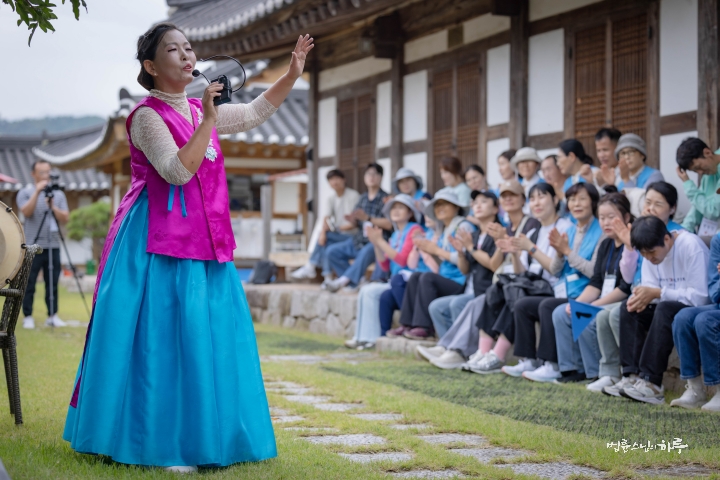
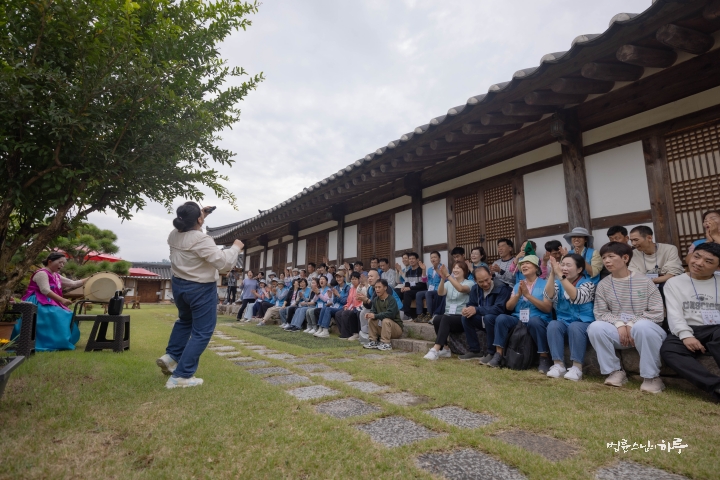
Sometimes the lyrics were understandable despite being a bit unclear, and other times they were difficult to make out. But it was all music. The residents returned to their seats amidst applause warmer than any professional singer would receive.
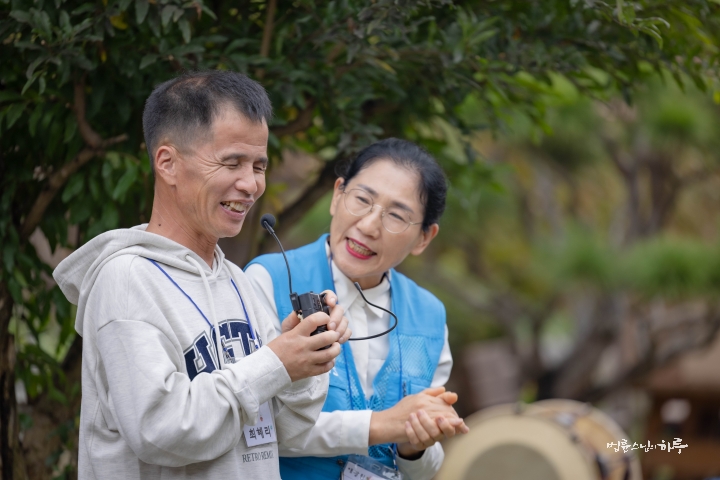
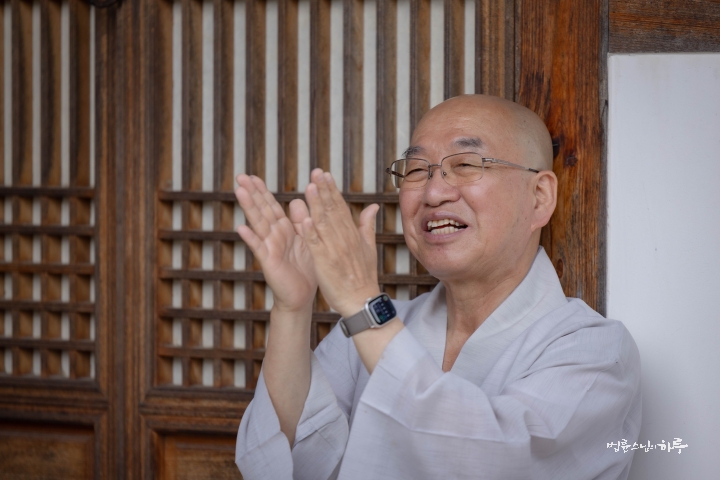
One person kept reaching out towards Sunim while singing this line:
“You were born to be loved”
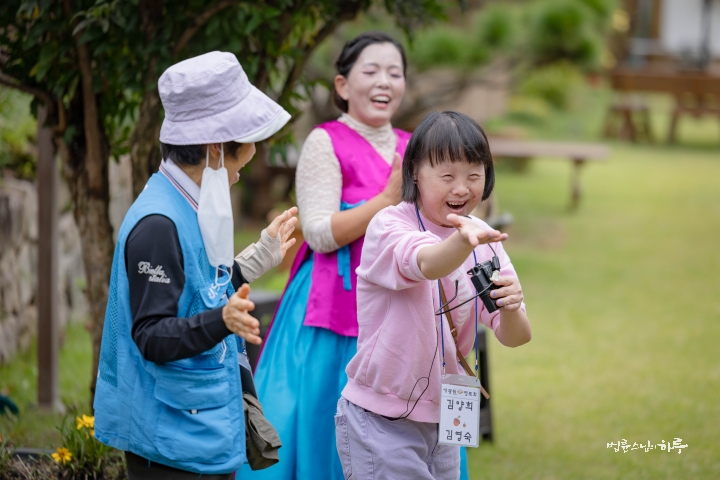
And before returning to their seat after finishing the song, she went to Sunim and shook his hand. Sunim also smiled brightly and clasped their hand.
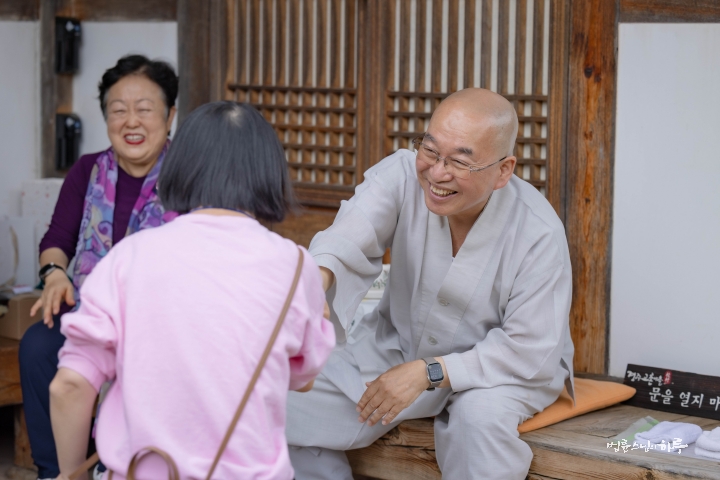
Today, not only did the residents showcase their singing skills, but they also showed off their dancing abilities. When one person started dancing to an upbeat song, several others came out and danced together.
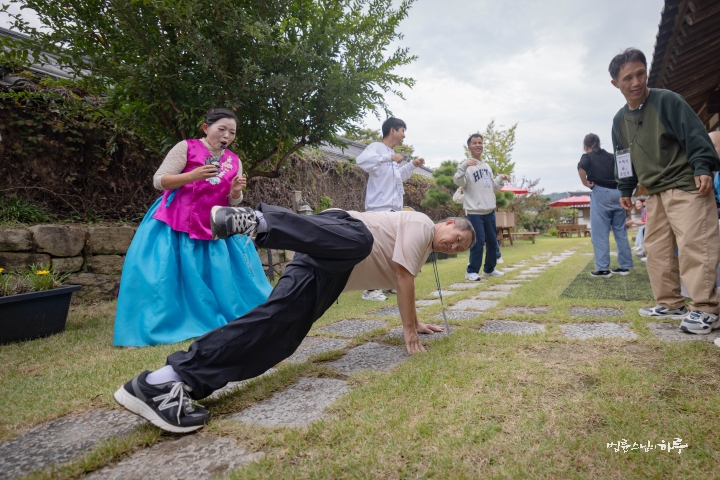
Regrettably, as the sun was setting, it was time to conclude the outing. Sunim presented gifts to the Aegwangwon staff and gave his final greetings.
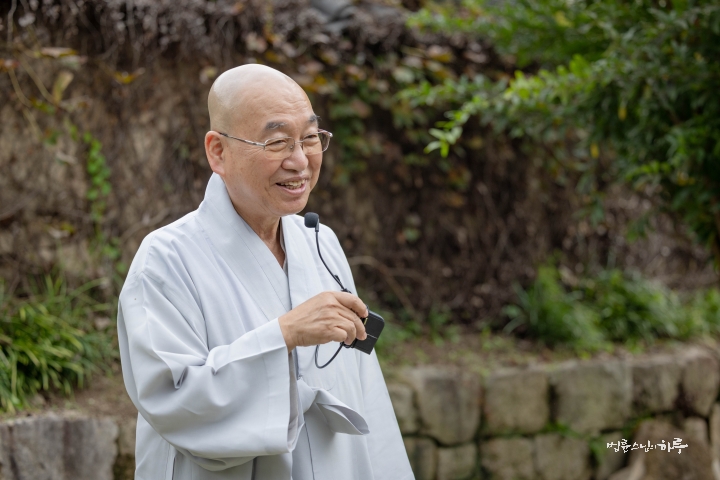
“Since the Aegwangwon teachers are working hard, I hope all of you will listen to them well. Always stay healthy. You should be in a good mood, just like when you were singing today. Understood?”
“Yes!”
“We’ll see you again next spring.”
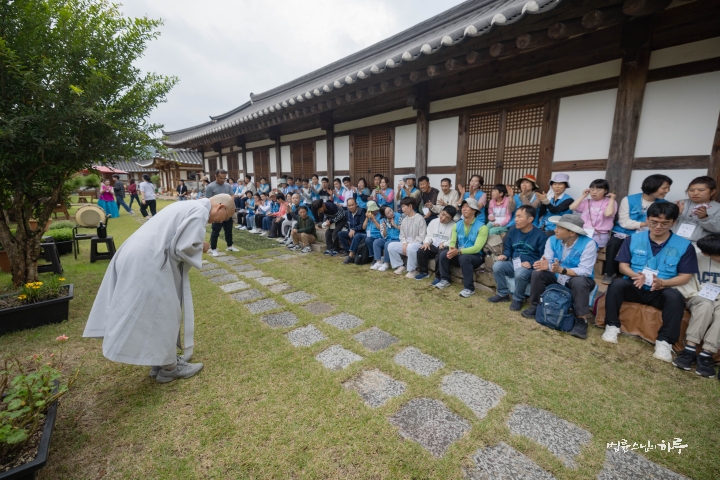
Finally, Ms. Song Woo-jeong, the director of Aegwangwon, gave the closing remarks.
It Was Touching to See Friends Who Usually Don’t Speak Singing
“Thank you for being such good companions to our friends for the entire day. We saw our friends being happier than ever as they ate together, took pictures together, and enjoyed the beautiful scenery together. Seeing that made me very happy too. It really touched my heart to see friends who usually don’t speak singing and having conversations with their companions. I’m truly grateful that you dedicated your valuable day entirely to our friends when you could have spent it doing other things. Although we may have different religious beliefs, we learn that we can become one through activities like this. I’m thankful to Venerable Pomnyun Sunim and the members of Jungto Society for always caring for our friends.”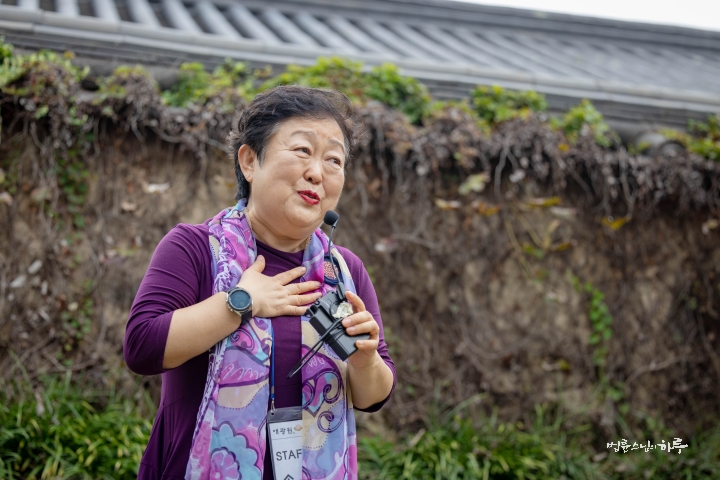
The director’s eyes welled up with tears. Sunim smiled and said:
“Amen!”
The director continued:
“Although words cannot fully express this gratitude, we will work hard to care for the Aegwangwon family along with the teachers and repay the kindness you’ve shown us. We will never forget the love Sunim has shown by not forgetting about Aegwangwon despite his busy schedule, always helping us, and even personally delivering harvested produce several times during the COVID-19 period.”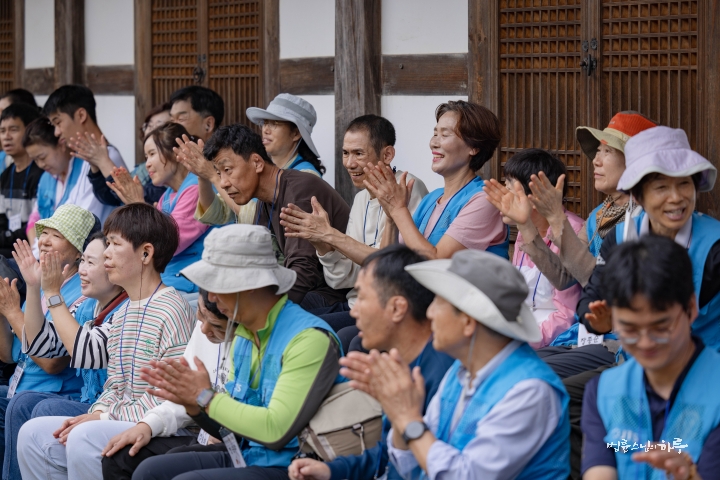
As the autumn outing came to an end, the residents of Aegwangwon gave each of their companions a box of cloud bread they had made themselves as a gift.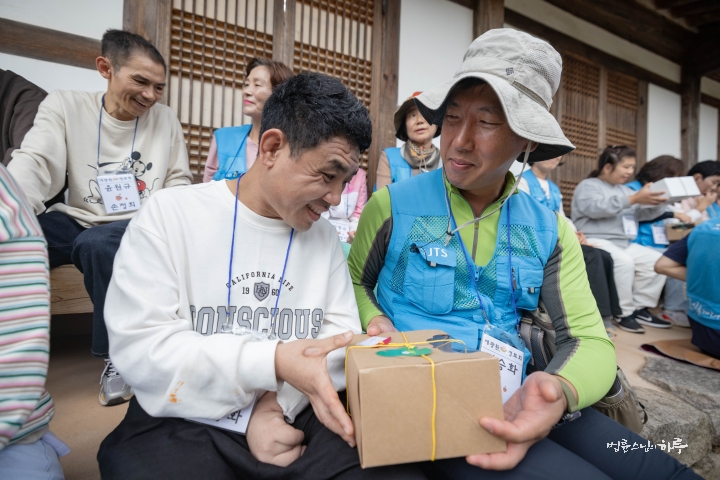
The volunteers were delighted to receive the boxes filled with the residents’ sincerity.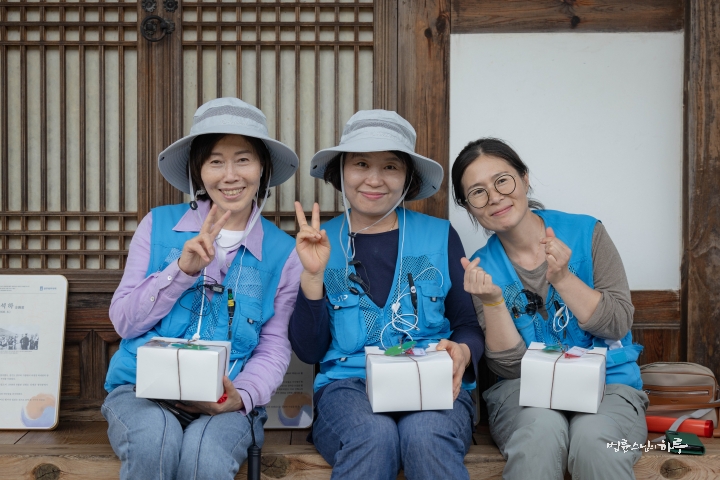
As the Aegwangwon family and volunteers headed to the dining hall for dinner, Sunim departed for Ulsan.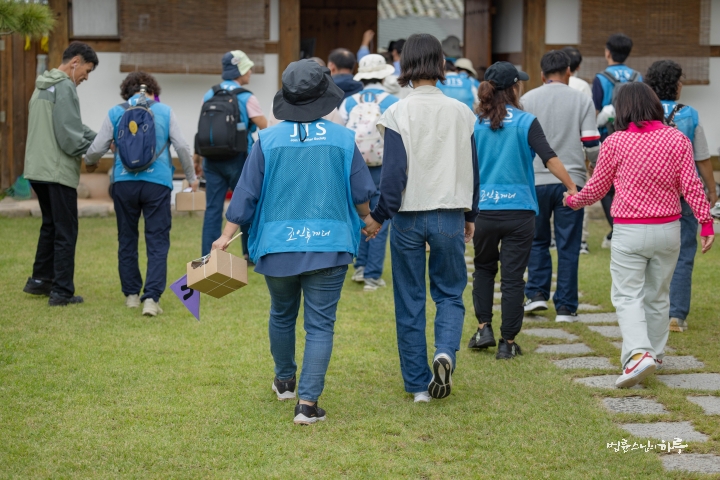
Following the book launch celebration for “Pureun Baedal Maljip” (a Korean dictionary explaining pure Korean words in Korean) held at the Seoul Jungto Social and Cultural Center on the 3rd, another celebration was held today at the Oesol Conference Room of the Ulsan Education Office. In the meantime, a new book titled “Our Language Love” was also published following “Pureun Baedal Maljip.”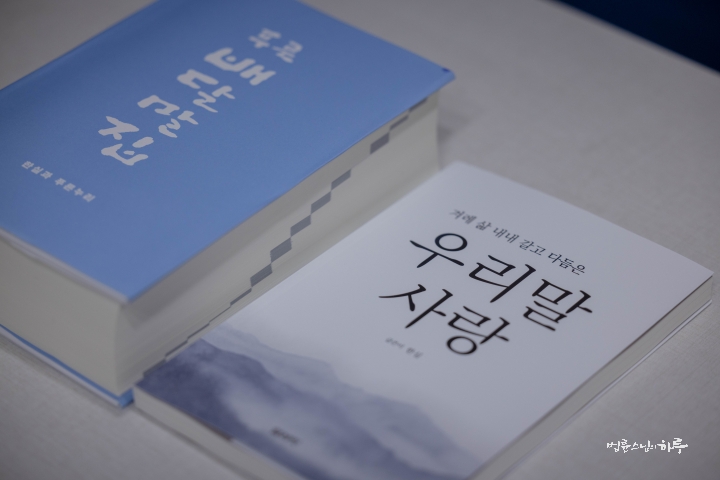
Sunim arrived at the Ulsan Education Office at 6:30 PM. Teacher Choi Han-sil was signing books. Sunim greeted the attendees warmly at the entrance. Mr. Jeon Chang-soo, the Superintendent of Ulsan City Education, also attended the book celebration and exchanged warm greetings.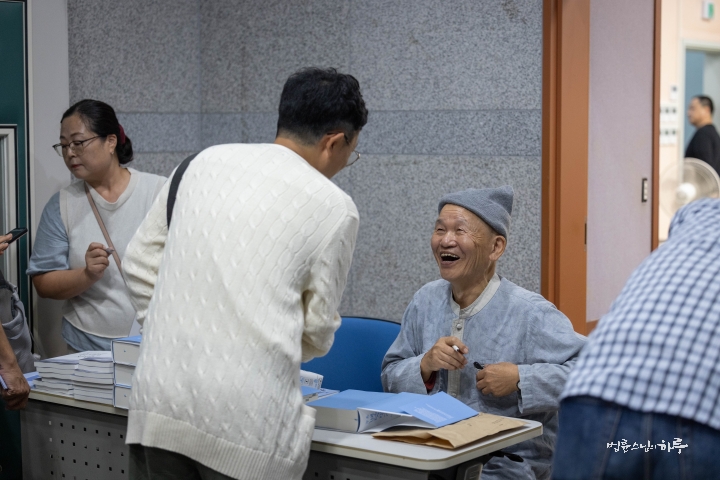
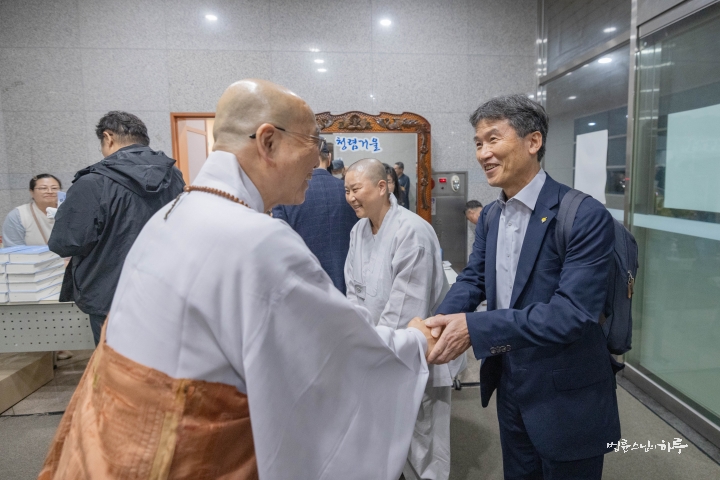
Amidst a gathering of people who have devoted much effort to cultivating the Korean language, the singing group ‘Hanpan’ from the Ulsan branch of the Korean Teachers and Education Workers Union opened the book celebration with beautiful, heart-touching songs.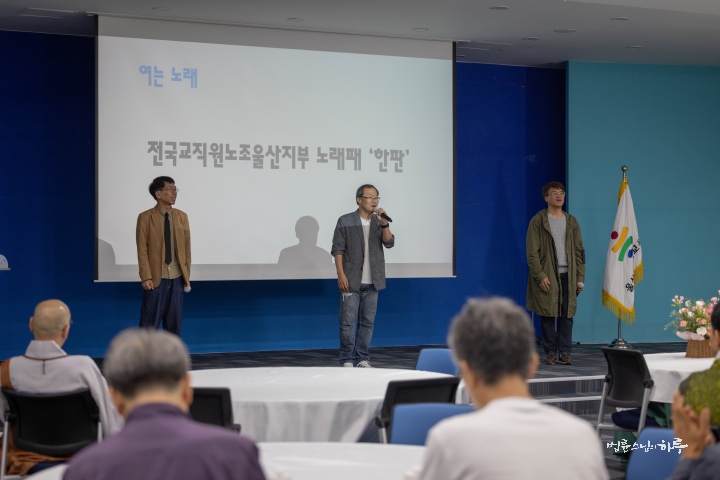
Next, Sunim was asked to give opening remarks. He emphasized that this dictionary was published after a long effort to recover lost Korean words and urged everyone to use these rediscovered Korean words widely.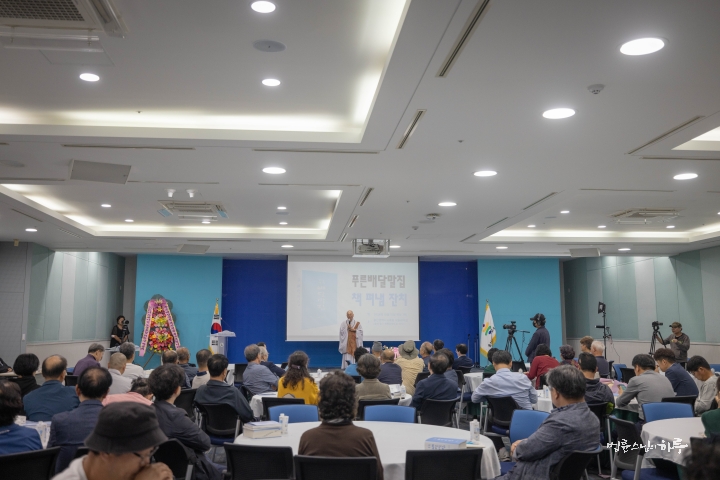
“I sincerely congratulate Teacher Choi Han-sil on the publication of ‘Pureun Baedal Maljip.’ I also congratulate the publication of ‘Our Language Love.'”
“I entered the temple while attending high school, so I received relatively less modern education. Some people tell me, ‘Sunim, you speak in such a simple way,’ but I didn’t try to speak simply. My words naturally became simpler because I have less formal education.” (Laughter)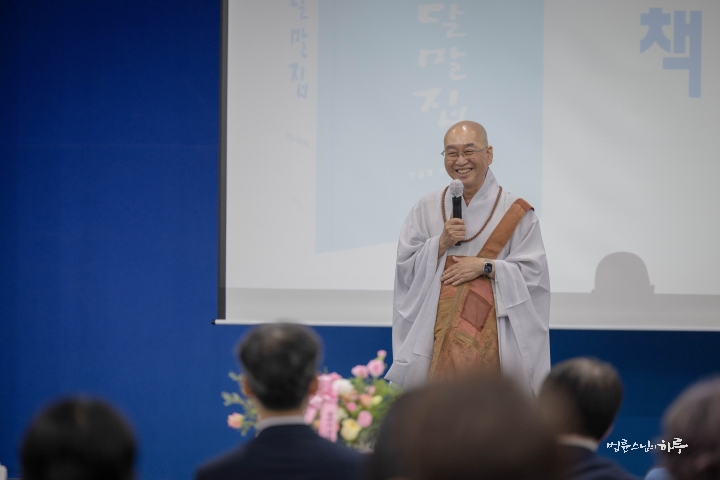
We can express our sincerity and truth using everyday language. However, those who have lived in temples for a long time or received university education tend to use difficult terminology. It seems that using complex words to appear knowledgeable has unconsciously become part of our culture. If I had not received high school education, or even elementary school education, I might not have needed to learn and practice the “Pure Korean Dictionary” as I do today. I could have expressed all my thoughts and feelings using the language I grew up with in my neighborhood.
Recently, I have been traveling around the world for relief activities and development support, and I see that Korean culture is having a tremendous global influence. Wherever I go, phrases like “annyeonghaseyo” (hello) and “gamsahamnida” (thank you) are naturally used. It’s similar to how we used to say “good morning” and “thank you” in English when we were young, even if we didn’t speak the language. Our culture is spreading widely in this manner. A few days ago, a Korean novelist received the Nobel Prize in Literature, a precious achievement highly regarded worldwide. Despite the excellence of our culture, why is our basic language dominated by foreign words? It’s not that our language was inherently lacking. While running schools in India and teaching Korean children’s songs translated into Indian languages, I noticed that words depicting actions like “sallang-sallang” (fluttering) or onomatopoeias like “kokio” (cock-a-doodle-doo) are rarely found in other languages. So when translating songs, we keep these mimetic and onomatopoeic words in Korean. They are simultaneously Korean words and representations of animal sounds or body movements. Children quickly understand when we use such expressions.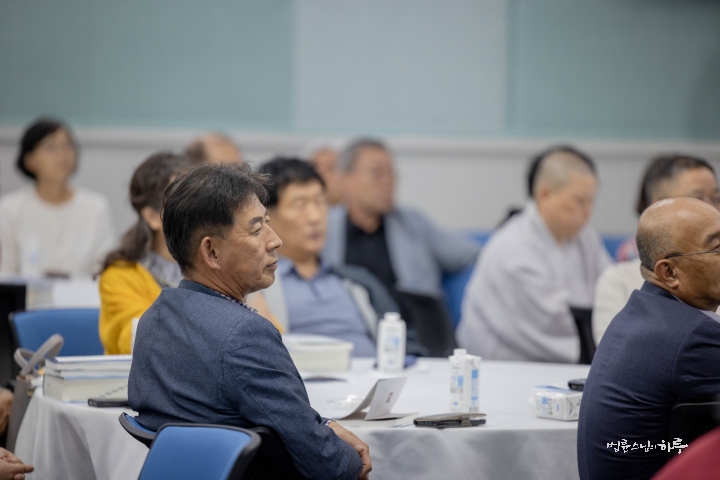
Challenges Faced by the Korean Language Throughout History
While studying our history, I’ve often pondered why foreign languages dominate our Korean language. The first crisis for our language seems to have arisen from our inability to write our spoken language using our own script. According to ancient history, we did have our own writing system called Garimto. Records show that during the Silla Dynasty, parts of it were adapted to create Idu. However, we ultimately failed to preserve our own script and ended up using Chinese characters to express our language. This led to a situation where, instead of language shaping writing, writing shaped language, resulting in the loss of many of our native words. During the Goryeo and Joseon dynasties, less than 5% of the population studied Confucianism. Even in later periods, those who knew Chinese characters did not exceed 10% of the population. As the script was used only by the upper class, the majority of people continued to use spoken Korean. Although they were looked down upon for not knowing the script, this ironically helped preserve our language from significant damage.
The second crisis for our language began during the Japanese colonial period. The Japanese implemented universal elementary education for our people, teaching children with textbooks in Japanese. After liberation, we simply transliterated these Japanese textbooks into Hangul to create our own. While the pronunciation was changed to Korean, the vocabulary remained the same as what the Japanese had created. For example, basic two-character Sino-Korean words like ‘bunbae’ (distribution) and ‘baebun’ (allocation) replaced our original terms. As a result, everyone who received compulsory elementary and middle school education learned and used these Sino-Korean terms created in Japan.
The third crisis for our language came with the influence of Western culture, particularly American culture, leading to the indiscriminate use of English and foreign loanwords. Korean intellectuals who studied abroad frequently pepper their speech with English words, and even those with just a high school education increasingly use foreign terms. Consequently, our native Korean vocabulary is gradually diminishing.
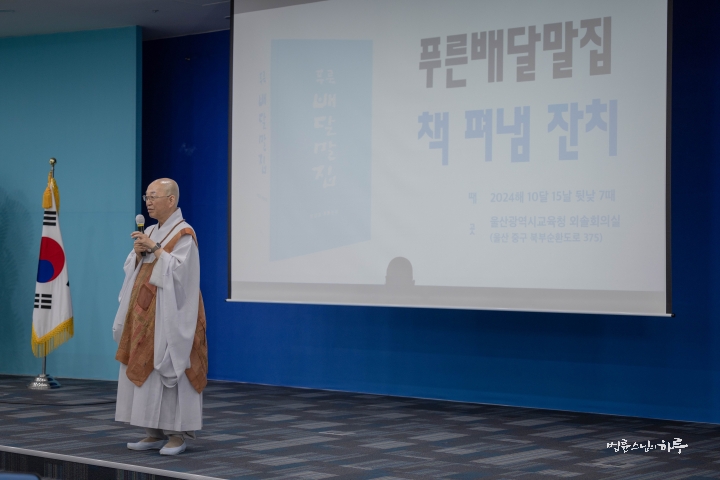
For Our Culture to Become a Source of New Creation
Many Koreans use Japanese-derived words without realizing they are not native Korean, as they are pronounced in Korean. Words like “gamsa” (thank you) and “annyeong” (hello) are often mistaken for pure Korean words, and we seem to lack awareness of this issue. During the Japanese colonial period, Japan abolished the Korean Lunar New Year and imposed the celebration of the solar New Year. Even after liberation, President Park Chung-hee designated only the solar New Year as a public holiday, but many farmers who had not received formal education continued to observe the Lunar New Year. Eventually, as Korea democratized, the Lunar New Year was recognized as a national holiday. This history shows that preserving our unique traditional culture is not nationalism, but rather crucial for maintaining our national and cultural identity. Because of this experience, when I engage in relief activities in various countries, I not only provide material support but also emphasize preserving local traditions through education. Just as we must prevent species extinction for biodiversity, we must also protect diverse minority cultures. As school culture becomes increasingly globalized, regional dialects and minority languages are disappearing within countries, and languages of smaller ethnic groups and nations are vanishing worldwide, which is a regrettable trend.
The current global phenomenon of the Korean Wave is not simply a result of imitating Western culture. It can be seen as a new civilization created from the fusion of our cultural identity and imported foreign elements. Always insisting on only one’s own identity leads to isolation, while mere imitation results in losing one’s identity. Creation occurs when we maintain our core identity while embracing external cultures. Throughout the history of civilization, nations on the periphery of mainstream civilizations, possessing their own unique cultural traits, have often advanced by adopting elements of advanced civilizations and creating new ones through innovation. The Aegean civilization developed on the fringes of Egyptian civilization, Greek civilization on the outskirts of Aegean civilization, and Roman civilization on the periphery of Greek civilization. It’s not simply a matter of preserving something because it’s ours. The point is that our contribution to the development of human civilization becomes possible when we maintain the uniqueness of our culture, which serves as a source of new creation.
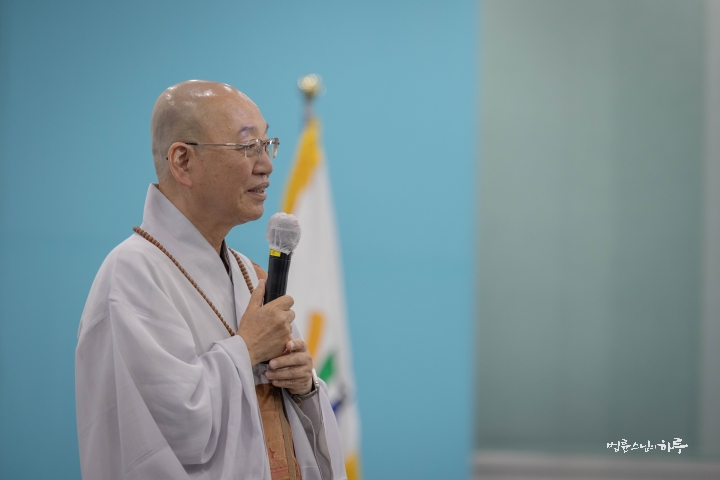
I hope we can go beyond simply thinking that we should preserve our language because it’s Korean. Instead, we should strive to use our language in a way that brings out its original meaning more fully. That’s why the title of this lecture is ‘Revitalizing the Use of Korean Language’. If there’s no equivalent term in Korean, or if a foreign expression is more precise than a Korean one, it’s acceptable to use it. However, we should avoid using foreign words when Korean alternatives exist, especially when the foreign terms are less accurate, simply because they might seem more sophisticated or profound.
Mr. Choi Han-sil, who published this book today, was not originally an expert in this field. However, over the past decade, he has invested considerable effort and personal funds to publish “The Blue Korean Dictionary” with this issue in mind. I’d like to express my gratitude once again for his hard work. Since this is my hometown, many of you here today are my seniors and juniors from this area. I hope we can all work together to ensure that Mr. Choi’s efforts don’t go to waste and help this book spread widely throughout our country.
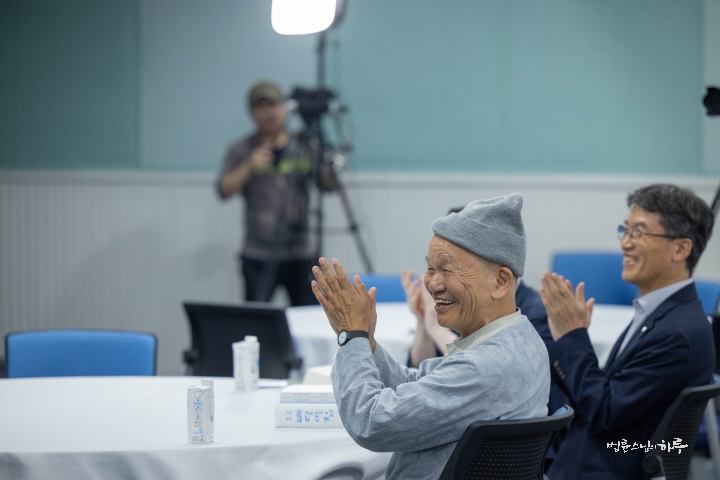
After watching a video about the creation of the book “Pureun Baedal Mal-jip” (A Collection of Pure Korean Words), Mirae introduced the people of Pureun Nuri. Following congratulatory speeches from the guests, Choi Han-sil began discussing “Using and Preserving Our Language.” Sunim listened attentively to Choi Han-sil’s talk before quietly leaving the conference room and heading to Seoul.
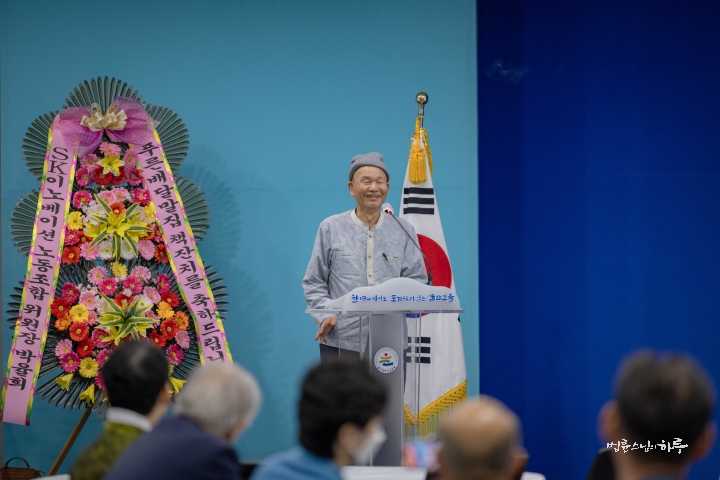
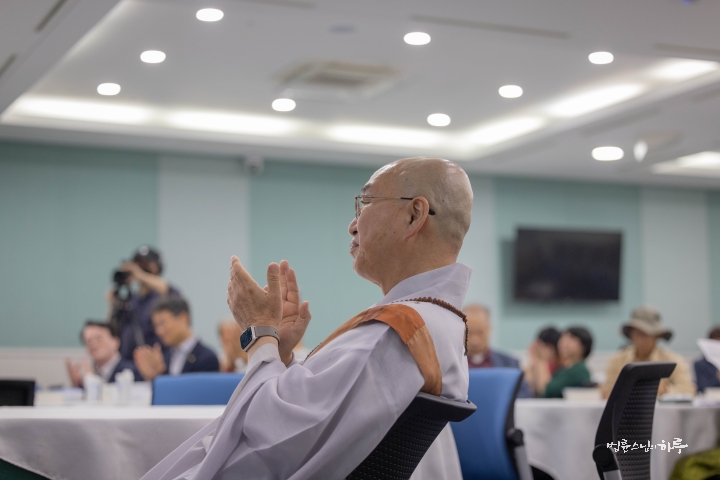
Departing from Ulsan at 8:30 PM, Sunim traveled on the highway for 4 hours and 30 minutes, arriving in Seoul at 1:00 AM.
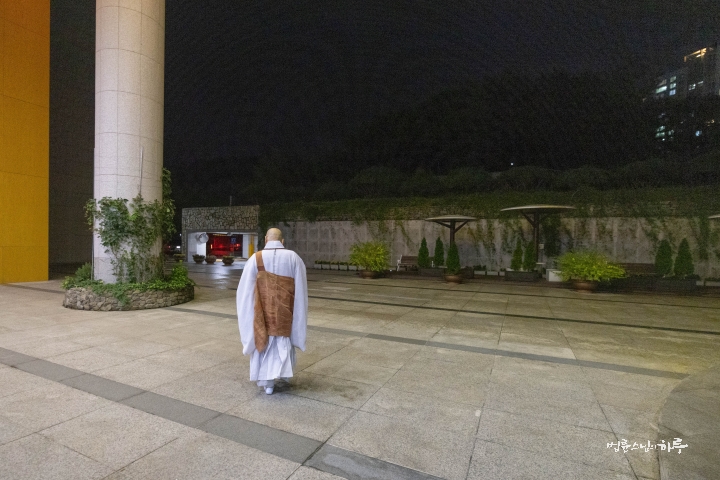
Tomorrow morning, Sunim will conduct a live-streamed Weekly Dharma Assembly for Jungto Society members. In the afternoon, he will attend the book launch party for “Hello Mindanao” organized by JTS and engage in discussions. In the evening, a special Dharma talk commemorating the 50th anniversary of Bulgwang will be held at the Jogyesa Traditional Culture and Art Performance Hall.


